Paul van Yperen's Blog, page 329
October 30, 2016
Lia Franca
Lia Franca aka Lya Franca (1912-1988) was an Italian film actress. After a breakthrough in 1930 and a peak in 1932 with Gli uomini che mascalzoni, she married and pulled the plug on her acting career.
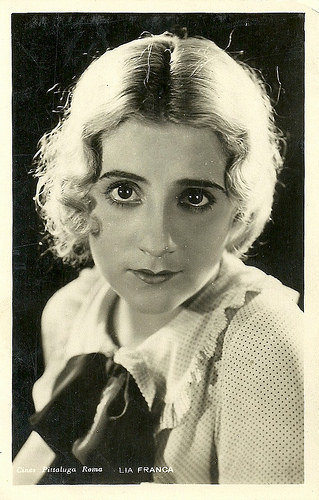
Italian postcard. Cines-Pittaluga, Roma.
Miss Trieste
As Pietro Spirito wrote in Il Piccolo in 2010, Lia Franca is "emblematic and representative of an era of cinema in which the Italian star system was modeled on styles and ways of Hollywood’s star system".
She was baptized in the New Church of St. Anthony as Livia Caterina Petra Penso in 1912. When she was just 14, her compatriot Marcella Battellini won a competition organized by the Fox Film Corporation, looking for new faces to be launched in Hollywood cinema. The winners chosen from the approximately forty thousand and thirty thousand women participants were respectively Alberto Rabagliati, who would become a popular Italian singer, and Marcella Battellini.
The news that a girl from Trieste could establish herself in film gave way to a whole series of competitions. The first was the Miss Trieste pageant in 1927, with thousands of participants, won by Argelia Lazardi, Ermy Metlica and Livia Penso. On the contest also a short film was made, Il trionfo di Venere/The Triumph of Venus, projected 20 to 23 May 1927 at the Cinema Corso in Trieste Corso.
Livia then moved to Turin, where she tried to work for the company Anonima Stefano Pittaluga but failed and finally moved to Rome. There she debuted in 1930 as Lia Franca in the short film Arietta antica, and then she had one of the leads in the courtcase drama Corte d’Assise/Before the Jury (Guido Brignone, 1930), starring Marcella Albani , Franca and Elio Steiner.
After that, she performed in Resurrectio/Resurrection (Alessandro Blasetti, 1931), about an orchestra conductor (Daniele Crespi) who premeditates suicide because of his lover dumping him but then is held back by an innocent young girl (Franca), who inspires him and causes his resurrection. The film was Italy’s first feature sound film produced, but producers considered it better to release it after La canzone dell’amore, in 1931. The film was shot twice after the negative was burned and the film sequestered, but critics had no mercy and still condemned the film. Blasetti himself judged it his biggest flop.
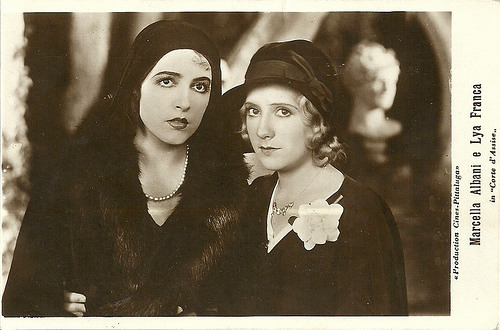
Italian postcard. Photo: Produzione Cines-Pittaluga. Marcella Albani and Lya Franca in the courtcase melodrama Corte d'Assise (Guido Brignone, 1930, released in 1931).
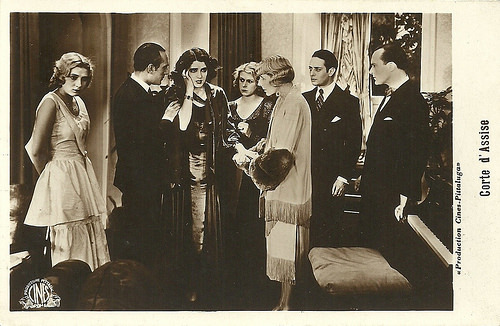
Italian postcard. Photo: Produzione Cines-Pittaluga. From left to right: Lya Franca, Renzo Ricci, Marcella Albani , and Mercedes Brignone , and at far right Elio Steiner, in the courtcase melodrama Corte d'Assise (Guido Brignone, 1930-1931).
Parlami d’amore
Lia Franca then played a minor part in La stella del cinema/The movie star (Mario Almirante, 1931), starring Grazia Del Rio.
Franca finally got her big role as Mariuccia, the shopgirl, in the romantic comedy Gli uomini, che mascalzoni…/What Rascals Men Are (Mario Camerini, 1932). Here a young Vittorio De Sica dedicates the famous song Parlami d’amore, Mariù to Franca’s Mariuccia. The film and the song were huge successes at the time, both inside and outside of Italy, turning De Sica into a full blown film star.
An important innovation in a time when most Italian films were shot in studios was to have a great deal of the film shot in exteriors, in Milan and on the Lakes. The story deals with private chauffeur Bruno who pretends he owns the rich family's car and takes shopgirl Mariuccia to the lakes. He meets the family there who order to drive them back to Milan, leaving Mariuccia behind. Afterwards he crashes the car trying to pick up the girl left behind and is fired. After many more adventures the two can finally reunite.
During this the production of the film, Franca met the assistant director Mario Sequi. They married shortly after the premiere of their film. Lia abandoned the cinema forever and never spoke to the press again.
Lia Franca died in Rome in 1988.
Tribute to Lia Franca. Source: I MILLE OCCHI (YouTube).
Sources: La burbuja rosa (Italian), Wikipedia (English and Italian) and .

Italian postcard. Cines-Pittaluga, Roma.
Miss Trieste
As Pietro Spirito wrote in Il Piccolo in 2010, Lia Franca is "emblematic and representative of an era of cinema in which the Italian star system was modeled on styles and ways of Hollywood’s star system".
She was baptized in the New Church of St. Anthony as Livia Caterina Petra Penso in 1912. When she was just 14, her compatriot Marcella Battellini won a competition organized by the Fox Film Corporation, looking for new faces to be launched in Hollywood cinema. The winners chosen from the approximately forty thousand and thirty thousand women participants were respectively Alberto Rabagliati, who would become a popular Italian singer, and Marcella Battellini.
The news that a girl from Trieste could establish herself in film gave way to a whole series of competitions. The first was the Miss Trieste pageant in 1927, with thousands of participants, won by Argelia Lazardi, Ermy Metlica and Livia Penso. On the contest also a short film was made, Il trionfo di Venere/The Triumph of Venus, projected 20 to 23 May 1927 at the Cinema Corso in Trieste Corso.
Livia then moved to Turin, where she tried to work for the company Anonima Stefano Pittaluga but failed and finally moved to Rome. There she debuted in 1930 as Lia Franca in the short film Arietta antica, and then she had one of the leads in the courtcase drama Corte d’Assise/Before the Jury (Guido Brignone, 1930), starring Marcella Albani , Franca and Elio Steiner.
After that, she performed in Resurrectio/Resurrection (Alessandro Blasetti, 1931), about an orchestra conductor (Daniele Crespi) who premeditates suicide because of his lover dumping him but then is held back by an innocent young girl (Franca), who inspires him and causes his resurrection. The film was Italy’s first feature sound film produced, but producers considered it better to release it after La canzone dell’amore, in 1931. The film was shot twice after the negative was burned and the film sequestered, but critics had no mercy and still condemned the film. Blasetti himself judged it his biggest flop.

Italian postcard. Photo: Produzione Cines-Pittaluga. Marcella Albani and Lya Franca in the courtcase melodrama Corte d'Assise (Guido Brignone, 1930, released in 1931).

Italian postcard. Photo: Produzione Cines-Pittaluga. From left to right: Lya Franca, Renzo Ricci, Marcella Albani , and Mercedes Brignone , and at far right Elio Steiner, in the courtcase melodrama Corte d'Assise (Guido Brignone, 1930-1931).
Parlami d’amore
Lia Franca then played a minor part in La stella del cinema/The movie star (Mario Almirante, 1931), starring Grazia Del Rio.
Franca finally got her big role as Mariuccia, the shopgirl, in the romantic comedy Gli uomini, che mascalzoni…/What Rascals Men Are (Mario Camerini, 1932). Here a young Vittorio De Sica dedicates the famous song Parlami d’amore, Mariù to Franca’s Mariuccia. The film and the song were huge successes at the time, both inside and outside of Italy, turning De Sica into a full blown film star.
An important innovation in a time when most Italian films were shot in studios was to have a great deal of the film shot in exteriors, in Milan and on the Lakes. The story deals with private chauffeur Bruno who pretends he owns the rich family's car and takes shopgirl Mariuccia to the lakes. He meets the family there who order to drive them back to Milan, leaving Mariuccia behind. Afterwards he crashes the car trying to pick up the girl left behind and is fired. After many more adventures the two can finally reunite.
During this the production of the film, Franca met the assistant director Mario Sequi. They married shortly after the premiere of their film. Lia abandoned the cinema forever and never spoke to the press again.
Lia Franca died in Rome in 1988.
Tribute to Lia Franca. Source: I MILLE OCCHI (YouTube).
Sources: La burbuja rosa (Italian), Wikipedia (English and Italian) and .
Published on October 30, 2016 23:00
October 29, 2016
André Baugé
André Baugé (1893-1966) was a French baritone, active in opera and operetta. He also appeared in films in the 1930s.
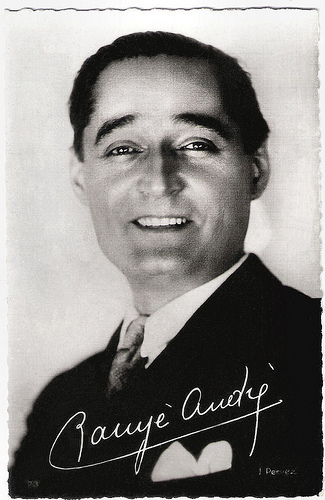
French postcard by E.C. (Editions Chantal), no. 73. Photo: J. Pervez.
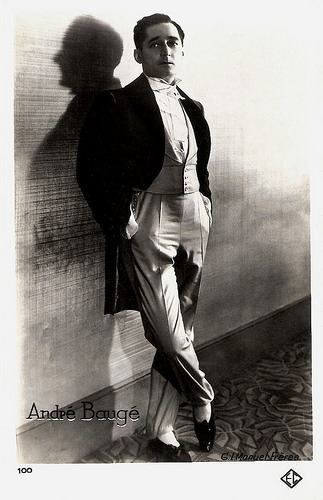
French postcard by E.C. (Editions Chantal), no. 100. Photo: G.L. Manuel Frères.
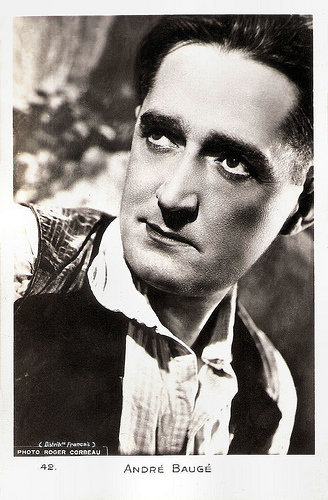
French postcard, no. 42. Photo: Roger Corbeau / Distrib. Français.
First Baritone
André Gaston Baugé was born in Toulouse, France, in 1893. He was the son of Alphonse Baugé, a vocal teacher, and Anna Tariol-Baugé a soprano active in operetta.
André studied with his parents and appeared in the French provinces billed as André Grilland. However, he also painted and had an exhibition at the Salons de la Société des Artistes Français. He decided to choose for the operetta, like his mother.
In 1917, he made his debut as first baritone at the Opéra-Comique in Paris as Frédéric in Lakmé. A pensionnaire at the Opéra-Comique until 1925, he appeared as Clément Marot in La Basoche, Sylvanus in Au Beau Jardin de France, Figaro in Le Barbier de Séville, Escamillo in Carmen, Alfio in Cavalleria Rusticana, Don Giovanni, Clavaroche in Fortunio, Lescaut in Manon, d’Orbel in La Traviata, Marcel in La boheme, Albert in Werther etc.
Baugé sang in the first performances at the Salle Favart of Béatrice, Masques et Bergamasques and Véronique. In 1925 he played Germont in Traviata and the title role in Mârouf. In 1925 he sang in the French premiere of Monsieur Beaucaire and moved into the field of comédie musicale and Viennese operetta.
A succession of appearances in that genre followed: Venise (alongside his mother) in 1927, Paganini in 1928, Vouvray in 1929 (for which he wrote the text), Le Clown amoureux in 1929, Robert le Pirate in 1929, Cinésonor in 1930 (also writing the text), Nina-Rosa in 1931, Valses de Vienne in 1933, Au temps des Merveilleuses in 1934, Au soleil du Mexique in 1935 and Le Chant du tzigane in 1937.
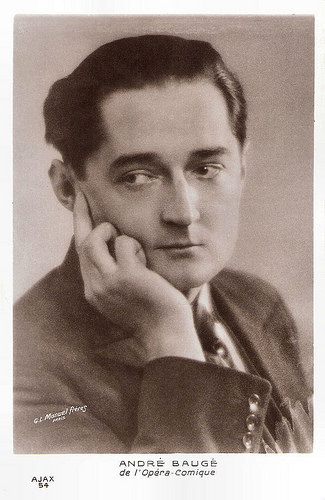
French postcard by Ajax, no. 54. Photo: G.L. Manuel Frères. Caption: André Baugé de l'Opéra-Comique.
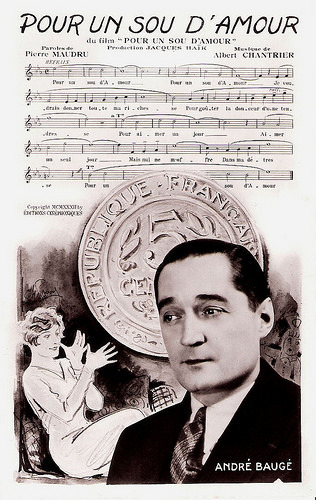
French postcard by P-C, Paris, no. 55. Image: Editions Cinéphoniques, 1932. Text and music of the title song of Pour un sou d'amour (1932), words by Pierre Maudru and music by Albert Chantrier.
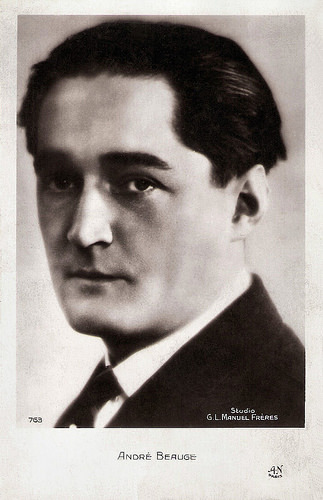
French postcard by AN, Paris, no. 763. Photo: Studio G.L. Manuel Frères.
Multiple-language versions
In the cinema, André Baugé made his debut in the silent film La fleur des Indes/The Flower of the Indies (Théo Bergerat, 1921) starring Huguette Duflos .
Nine years later he appeared in La Route est belle (Robert Florey, 1930), one of the first French sound films with music by Szulc. As no French studios had been converted for sound film, it was shot at Elstree Studios in Britain.
In Germany he starred opposite Liane Haid and Willi Forst in Petit officier... Adieu! (Géza von Bolváry, 1930), an alternate-language version of the operetta Das Lied ist aus (Géza von Bolváry, 1930). Multiple-language versions were common in the years following the introduction of sound film, before the practice of dubbing became widespread.
The next year, he had a supporting part in another example, Le petit café/The Little Cafe (Ludwig Berger, 1931), a French-language American Pre-Code musical film starring Maurice Chevalier . The film is a foreign-language version of Playboy of Paris (Ludwig Berger, 1930). The film received a better reception from critics than the English-language version had.
In the following years, he appeared in some other films including the opera adaptation Le barbier de Séville/The Barber of Seville (Hubert Bourlon, Jean Kemm, 1936), and Le roman d'un jeune homme pauvre/The novel of a young poor man (Abel Gance, 1935) featuring Pierre Fresnay .
Then Baugé returned to the theatre. He also contributed to the books of several productions (Vouvray, Cinésonor) he designed the cover for the score of Venise by Richepin. He was for a time the director of the Trianon-Lyrique in Paris. Baugé was the author of the libretto of an opéra-bouffe in three acts entitled tableaux Beaumarchais, using Rossini's music arranged by Eugène Cools, which was premiered at the Théâtre des Variétés in Marseille in 1931.
After the war he taught at the École Normale, returning to the theatre in 1958 as Johann Strauss senior in Valses de Vienne. He left recordings of songs from many of his roles, and some of these have been re-issued on CD.
André Baugé died in 1966 in Clichy-la-Garenne, France. He was 73. His wife was the singer Suzanna Laydeker, who also appeared as Laydeker-Baugé. She died in 1980.
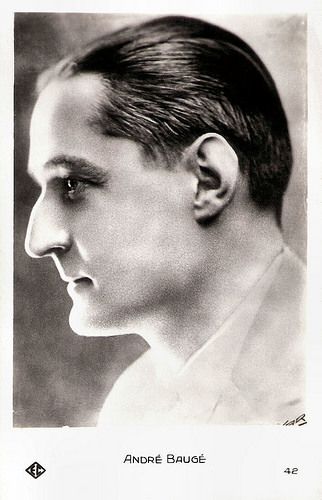
French postcard by E.C., no. 42. Photo: Var.
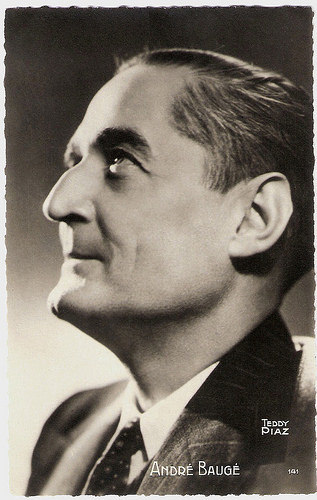
French postcard by Editions O.P., Paris, no. 141. Photo: Teddy Piaz.
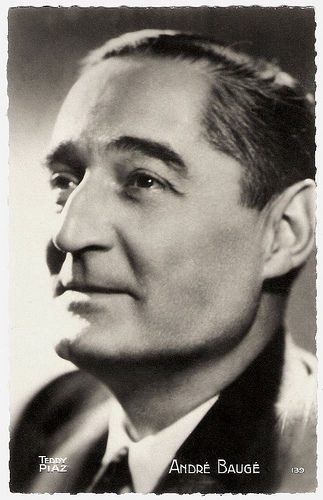
French postcard by Editions O.P., Paris, no. 139. Photo: Teddy Piaz.
Sources: Wikipedia (English and French) and .

French postcard by E.C. (Editions Chantal), no. 73. Photo: J. Pervez.

French postcard by E.C. (Editions Chantal), no. 100. Photo: G.L. Manuel Frères.

French postcard, no. 42. Photo: Roger Corbeau / Distrib. Français.
First Baritone
André Gaston Baugé was born in Toulouse, France, in 1893. He was the son of Alphonse Baugé, a vocal teacher, and Anna Tariol-Baugé a soprano active in operetta.
André studied with his parents and appeared in the French provinces billed as André Grilland. However, he also painted and had an exhibition at the Salons de la Société des Artistes Français. He decided to choose for the operetta, like his mother.
In 1917, he made his debut as first baritone at the Opéra-Comique in Paris as Frédéric in Lakmé. A pensionnaire at the Opéra-Comique until 1925, he appeared as Clément Marot in La Basoche, Sylvanus in Au Beau Jardin de France, Figaro in Le Barbier de Séville, Escamillo in Carmen, Alfio in Cavalleria Rusticana, Don Giovanni, Clavaroche in Fortunio, Lescaut in Manon, d’Orbel in La Traviata, Marcel in La boheme, Albert in Werther etc.
Baugé sang in the first performances at the Salle Favart of Béatrice, Masques et Bergamasques and Véronique. In 1925 he played Germont in Traviata and the title role in Mârouf. In 1925 he sang in the French premiere of Monsieur Beaucaire and moved into the field of comédie musicale and Viennese operetta.
A succession of appearances in that genre followed: Venise (alongside his mother) in 1927, Paganini in 1928, Vouvray in 1929 (for which he wrote the text), Le Clown amoureux in 1929, Robert le Pirate in 1929, Cinésonor in 1930 (also writing the text), Nina-Rosa in 1931, Valses de Vienne in 1933, Au temps des Merveilleuses in 1934, Au soleil du Mexique in 1935 and Le Chant du tzigane in 1937.

French postcard by Ajax, no. 54. Photo: G.L. Manuel Frères. Caption: André Baugé de l'Opéra-Comique.

French postcard by P-C, Paris, no. 55. Image: Editions Cinéphoniques, 1932. Text and music of the title song of Pour un sou d'amour (1932), words by Pierre Maudru and music by Albert Chantrier.

French postcard by AN, Paris, no. 763. Photo: Studio G.L. Manuel Frères.
Multiple-language versions
In the cinema, André Baugé made his debut in the silent film La fleur des Indes/The Flower of the Indies (Théo Bergerat, 1921) starring Huguette Duflos .
Nine years later he appeared in La Route est belle (Robert Florey, 1930), one of the first French sound films with music by Szulc. As no French studios had been converted for sound film, it was shot at Elstree Studios in Britain.
In Germany he starred opposite Liane Haid and Willi Forst in Petit officier... Adieu! (Géza von Bolváry, 1930), an alternate-language version of the operetta Das Lied ist aus (Géza von Bolváry, 1930). Multiple-language versions were common in the years following the introduction of sound film, before the practice of dubbing became widespread.
The next year, he had a supporting part in another example, Le petit café/The Little Cafe (Ludwig Berger, 1931), a French-language American Pre-Code musical film starring Maurice Chevalier . The film is a foreign-language version of Playboy of Paris (Ludwig Berger, 1930). The film received a better reception from critics than the English-language version had.
In the following years, he appeared in some other films including the opera adaptation Le barbier de Séville/The Barber of Seville (Hubert Bourlon, Jean Kemm, 1936), and Le roman d'un jeune homme pauvre/The novel of a young poor man (Abel Gance, 1935) featuring Pierre Fresnay .
Then Baugé returned to the theatre. He also contributed to the books of several productions (Vouvray, Cinésonor) he designed the cover for the score of Venise by Richepin. He was for a time the director of the Trianon-Lyrique in Paris. Baugé was the author of the libretto of an opéra-bouffe in three acts entitled tableaux Beaumarchais, using Rossini's music arranged by Eugène Cools, which was premiered at the Théâtre des Variétés in Marseille in 1931.
After the war he taught at the École Normale, returning to the theatre in 1958 as Johann Strauss senior in Valses de Vienne. He left recordings of songs from many of his roles, and some of these have been re-issued on CD.
André Baugé died in 1966 in Clichy-la-Garenne, France. He was 73. His wife was the singer Suzanna Laydeker, who also appeared as Laydeker-Baugé. She died in 1980.

French postcard by E.C., no. 42. Photo: Var.

French postcard by Editions O.P., Paris, no. 141. Photo: Teddy Piaz.

French postcard by Editions O.P., Paris, no. 139. Photo: Teddy Piaz.
Sources: Wikipedia (English and French) and .
Published on October 29, 2016 23:00
October 28, 2016
Imported from the USA: Anthony Quinn
Mexican-American actor Anthony Quinn (1915-2001) started as a contract player at Paramount, where he mainly played villains and ethnic types. He moved to Broadway and replaced Marlon Brando in A Streetcar Named Desire. This performance boosted his film career. For his role as Brando's brother in Viva Zapata! (Elia Kazan, 1952), Quinn won the Best Supporting Actor Academy Award. He gave one of his best performances as the circus strongman in Federico Fellini's masterpiece La Strada (1954). Quinn won his second Supporting Actor Oscar in 1957 for his role as Gauguin in Lust for Life (Vincente Minnelli, 1956), opposite Kirk Douglas as Vincent van Gogh. Over the next decades Quinn alternated between Hollywood and the European cinema.
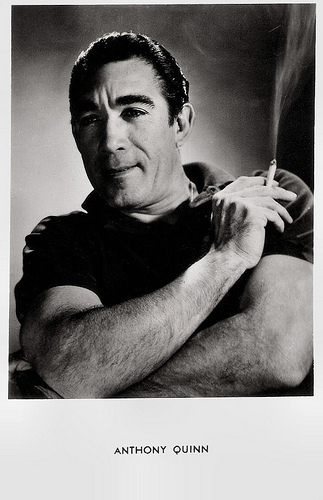
Dutch postcard, no. GR-5082.
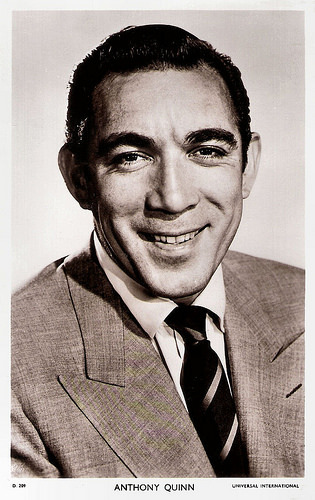
British postcard in the Picturegoer Series, London, no. D. 209. Photo: Universal International.
The Son-in-law of Cecil B. DeMille
Antonio Rudolfo Oaxaca Quinn was born in 1915, in Chihuahua, Mexico. His parents were Manuela (Oaxaca) and Francisco Quinn. After starting life in extremely modest circumstances in Mexico, his family moved to Los Angeles, where his father became an assistant cameraman at the Selig Film Studios. Quinn often accompanied his father to work, and became acquainted with such stars as Tom Mix and John Barrymore, with whom he kept up the friendship into adulthood.
He attended Polytechnic High School and later Belmont High, but eventually dropped out. The young Quinn boxed which stood him in good stead as a stage actor, when years later, he played Stanley Kowalski in A Streetcar Named Desire. He won a scholarship to study architecture under Frank Lloyd Wright at the great architect's studio, Taliesin, in Arizona. Quinn was close to Wright, who encouraged him when he decided to give acting a try.
After a brief apprenticeship on stage, Quinn hit Hollywood. He made his film debut with a character role in the crime drama Parole! (Lew Landers, 1936). Quinn picked up a variety of small roles in several films at Paramount, including a Cheyenne Indian in The Plainsman (1936), which was directed by his future father-in-law, Cecil B. DeMille. As a contract player at Paramount, Quinn mainly played villains and ethnic types, such as a gangster in the crime drama Dangerous to Know (Robert Florey, 1938), a Chinese gangster in Island of Lost Men (Kurt Neumann, 1939) and an Arab chieftain in the Bing Crosby-Bob Hope vehicle Road to Morocco (David Butler, 1942). He also played the sympathetic Crazy Horse in They Died with Their Boots On (Raoul Walsh, 1941) with Errol Flynn.
As a Mexican national (he did not become an American citizen until 1947), he was exempt from the draft. With many actors in the service fighting World War II, Quinn was able to move up into better supporting roles. He had married DeMille's daughter Katherine DeMille, which afforded him entrance to the top circles of Hollywood society. However, he became disenchanted with playing supporting parts as Chief Yellow Hand in Buffalo Bill (William A. Wellman, 1944) and a Chinese in China Sky (China Sky (Ray Enright, 1945). His first lead was the Indian farmer Charlie Eagle in Black Gold (Phil Karlson, 1947) opposite his wife, Katherine DeMille.
By 1947, he had appeared in more than fifty films and was still not a major star. He did not renew his Paramount contract despite the advice of others, including his father-in-law whom Quinn felt never accepted him due to his Mexican roots. Instead, he returned to the stage. His portrayal of Stanley Kowalski in A Streetcar Named Desire in Chicago and on Broadway, where he replaced Marlon Brando , made his reputation.
However, IMDb also gives another explanation for his move to the stage: “Became a naturalized United States citizen in 1947, just before he was ‘gray-listed’ for his association with Communists such as screenwriter John Howard Lawson and what were termed ‘fellow travelers’, though he himself was never called before the House of Un-American Activities Committee. When warned of his gray-listing by 20th Century-Fox boss Darryl F. Zanuck (a liberal), Quinn decided to go on the Broadway stage where there was no blacklist rather than go through the process of refuting the suspicions.”
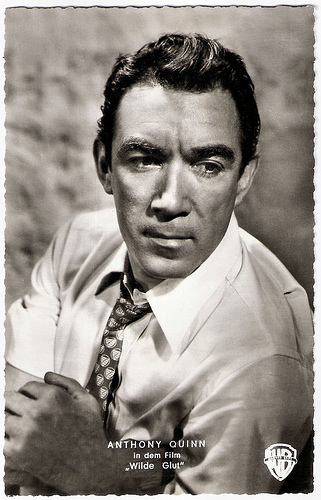
German postcard by Kunst und Bild, no. T 882. Photo: Warner Bros. Publicity still for Blowing Wild (Hugo Fregonese, 1953).
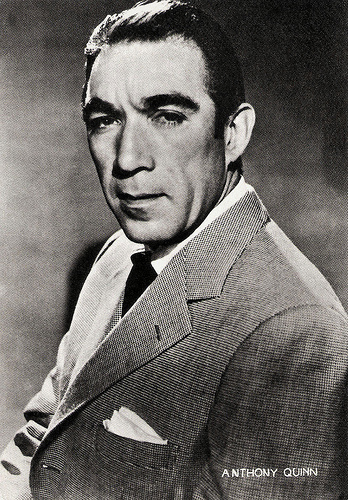
French postcard by Editions P.I. / Humour à la Carte, Paris, no. 3356. Photo: United Artists.
The first Mexican-American Oscar winner
Anthony Quinn’s success on Broadway boosted his film career. He returned to the cinema in The Brave Bulls (Robert Rossen, 1951). Director Elia Kazan then cast him as Marlon Brando 's brother in his biographical film of Mexican revolutionary Emiliano Zapata, Viva Zapata! (1952). Quinn won the Best Supporting Actor Academy Award for 1952, making him the first Mexican-American to win an Oscar.
It was not to be his lone appearance in the winner's circle: he won his second Supporting Actor Oscar five years later for his portrayal of painter Paul Gauguin in Vincente Minnelli's biographical film of Vincent van Gogh, Lust for Life (1956), opposite Kirk Douglas.
Over the next decade Quinn lived in Italy and became a major figure in world cinema, as many studios shot films in Italy to take advantage of the lower costs. He appeared in several Italian films, giving one of his greatest performances as the dim-witted, thuggish and volatile circus strongman who brutalises the sweet soul played by Giulietta Masina in her husband Federico Fellini's masterpiece La Strada (1954).
Alternating between Europe and Hollywood, Quinn built his reputation and entered the front rank of character actors and character leads. He received his third Oscar nomination (and first for Best Actor) for Wild Is the Wind (George Cukor, 1957). Quinn starred in The Savage Innocents (Nicholas Ray, 1959) as Inuk, an Eskimo who finds himself caught between two clashing cultures. He played a Greek resistance fighter against the Nazi occupation in the box office hit The Guns of Navarone (J. Lee Thompson, 1961) and received praise for his portrayal of a once-great boxer on his way down in Requiem for a Heavyweight (Ralph Nelson, 1962).
Back on Broadway, he was nominated for the 1961 Tony Award as Best Actor (Dramatic) for his part as as King Henry II opposite Laurence Olivier as Thomas Becket in Becket (Becket ou l'honneur de Dieu) by Jean Anouilh. He returned to the cinema to play ethnic parts, such as an Arab warlord in David Lean's masterpiece Lawrence of Arabia (1962), and he played the eponymous lead in the Sword-and-sandal blockbuster Barabbas (Richard Fleischer, 1961) opposite Silvana Mangano .
Two years later he reached the zenith of his career, playing Zorba in Alexis Zorbas/Zorba the Greek (Michael Cacoyannis, 1964)), which brought him his fourth, and last, Oscar nomination as Best Actor. The 1960s were kind to him: he played character leads in such major films as The Shoes of the Fisherman (Michael Anderson, 1968) opposite Laurence Olivier , and The Secret of Santa Vittoria (Stanley Kramer, 1969), with Anna Magnani . However, his appearance in the title role in the film adaptation of John Fowles' novel, The Magus (Guy Green, 1968), did nothing to save the film, which was one of that decade's notorious turkeys.
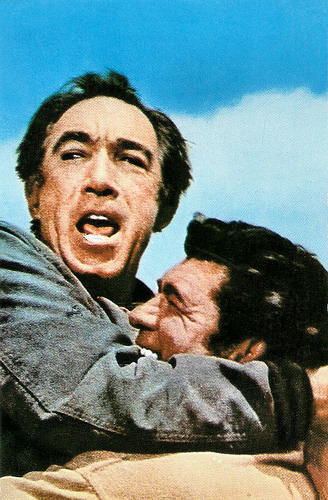
Romanian postcard by Casa Filmului Acin, no. 166. Photo: publicity still for Flap (Carol Reed, 1970).
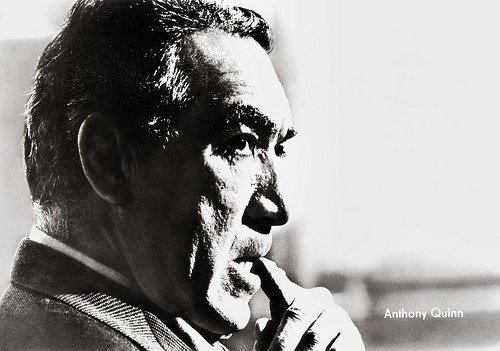
Big East-German collectors card by Progress Film-Verleih, Berlin, no. 15/82.
Not an authentic black hero
The following decade saw Anthony Quinn slip back into playing ethnic types again. He starred as the Hispanic mayor of a rapidly growing city in Southwest United States in the TV series The Man and the City (1971).
IMDb writes about an interesting incident: “Around 1972, he announced his desire to play Henry Cristophe, the 19th-century emperor of Haiti. Upon this announcement, several prominent black actors, including Ossie Davis and Ellen Holly, stated that they were opposed to a ‘white man’ playing ‘black’. Davis stated, ‘My black children need black heroes on which to model their behavior. Henry Cristophe is an authentic black hero. Tony, for all my admiration of him as a talent, will do himself and my children a great disservice if he encourages them to believe that only a white man, and Tony is white to my children, is capable of playing a black hero.’”
Quinn’s career lost its momentum during the 1970s. Aside from playing a thinly disguised Aristotle Onassis in the cinematic roman-a-clef The Greek Tycoon (J. Lee Thompson, 1978), his other major roles of the decade were as Hamza in the controversial The Message/Mohammad, Messenger of God (Moustapha Akkad, 1976), as the Italian patriarch in L'eredità Ferramonti/The Inheritance (Mauro Bolognini, 1976) opposite Dominique Sanda , yet another Arab in Caravans (James Fargo, 1978) and a Mexican patriarch in The Children of Sanchez (Hall Bartlett, 1978) with Dolores Del Rio .
In 1983 he reprised his most famous role, Zorba the Greek, on Broadway in the revival of the musical Zorba, for 362 performances. Though his film career slowed during the 1990s, he continued to work steadily in films and television, such as in the HBO original crime drama Gotti: The Rise and Fall of a Real Life Mafia Don (Robert Harmon, 1996). Quinn lived out the latter years of his life in Bristol, Rhode Island, where he spent most of his time painting and sculpting. His final film was the Sylvester Stallone vehicle Avenging Angelo (Martyn Burke, 2002).
In 2001, Anthony Quinn died in a hospital in Boston from pneumonia and respiratory failure linked to his battle with lung cancer. Quinn was 86 years old. He was married three times. After divorcing Katherine DeMille in 1965, he married Italian costume designer Jolanda Addolori (1966-1997) and after their divorce with his secretary, Kathy Benvin (1997-2001). He had ten children, five with DeMille, three with Addolori, and two with Benvin.
Trailer La Strada (1954). Source: Blondinka Inoz (YouTube).
Trailer Alexis Zorbas/Zorba the Greek (1964). Source: Fernando Braz (YouTube).
Trailer The Shoes of the Fisherman (1968). Source: Movieclips Trailer Vault (YouTube).
Sources: (IMDb), (IMDb), Wikipedia, and .

Dutch postcard, no. GR-5082.

British postcard in the Picturegoer Series, London, no. D. 209. Photo: Universal International.
The Son-in-law of Cecil B. DeMille
Antonio Rudolfo Oaxaca Quinn was born in 1915, in Chihuahua, Mexico. His parents were Manuela (Oaxaca) and Francisco Quinn. After starting life in extremely modest circumstances in Mexico, his family moved to Los Angeles, where his father became an assistant cameraman at the Selig Film Studios. Quinn often accompanied his father to work, and became acquainted with such stars as Tom Mix and John Barrymore, with whom he kept up the friendship into adulthood.
He attended Polytechnic High School and later Belmont High, but eventually dropped out. The young Quinn boxed which stood him in good stead as a stage actor, when years later, he played Stanley Kowalski in A Streetcar Named Desire. He won a scholarship to study architecture under Frank Lloyd Wright at the great architect's studio, Taliesin, in Arizona. Quinn was close to Wright, who encouraged him when he decided to give acting a try.
After a brief apprenticeship on stage, Quinn hit Hollywood. He made his film debut with a character role in the crime drama Parole! (Lew Landers, 1936). Quinn picked up a variety of small roles in several films at Paramount, including a Cheyenne Indian in The Plainsman (1936), which was directed by his future father-in-law, Cecil B. DeMille. As a contract player at Paramount, Quinn mainly played villains and ethnic types, such as a gangster in the crime drama Dangerous to Know (Robert Florey, 1938), a Chinese gangster in Island of Lost Men (Kurt Neumann, 1939) and an Arab chieftain in the Bing Crosby-Bob Hope vehicle Road to Morocco (David Butler, 1942). He also played the sympathetic Crazy Horse in They Died with Their Boots On (Raoul Walsh, 1941) with Errol Flynn.
As a Mexican national (he did not become an American citizen until 1947), he was exempt from the draft. With many actors in the service fighting World War II, Quinn was able to move up into better supporting roles. He had married DeMille's daughter Katherine DeMille, which afforded him entrance to the top circles of Hollywood society. However, he became disenchanted with playing supporting parts as Chief Yellow Hand in Buffalo Bill (William A. Wellman, 1944) and a Chinese in China Sky (China Sky (Ray Enright, 1945). His first lead was the Indian farmer Charlie Eagle in Black Gold (Phil Karlson, 1947) opposite his wife, Katherine DeMille.
By 1947, he had appeared in more than fifty films and was still not a major star. He did not renew his Paramount contract despite the advice of others, including his father-in-law whom Quinn felt never accepted him due to his Mexican roots. Instead, he returned to the stage. His portrayal of Stanley Kowalski in A Streetcar Named Desire in Chicago and on Broadway, where he replaced Marlon Brando , made his reputation.
However, IMDb also gives another explanation for his move to the stage: “Became a naturalized United States citizen in 1947, just before he was ‘gray-listed’ for his association with Communists such as screenwriter John Howard Lawson and what were termed ‘fellow travelers’, though he himself was never called before the House of Un-American Activities Committee. When warned of his gray-listing by 20th Century-Fox boss Darryl F. Zanuck (a liberal), Quinn decided to go on the Broadway stage where there was no blacklist rather than go through the process of refuting the suspicions.”

German postcard by Kunst und Bild, no. T 882. Photo: Warner Bros. Publicity still for Blowing Wild (Hugo Fregonese, 1953).

French postcard by Editions P.I. / Humour à la Carte, Paris, no. 3356. Photo: United Artists.
The first Mexican-American Oscar winner
Anthony Quinn’s success on Broadway boosted his film career. He returned to the cinema in The Brave Bulls (Robert Rossen, 1951). Director Elia Kazan then cast him as Marlon Brando 's brother in his biographical film of Mexican revolutionary Emiliano Zapata, Viva Zapata! (1952). Quinn won the Best Supporting Actor Academy Award for 1952, making him the first Mexican-American to win an Oscar.
It was not to be his lone appearance in the winner's circle: he won his second Supporting Actor Oscar five years later for his portrayal of painter Paul Gauguin in Vincente Minnelli's biographical film of Vincent van Gogh, Lust for Life (1956), opposite Kirk Douglas.
Over the next decade Quinn lived in Italy and became a major figure in world cinema, as many studios shot films in Italy to take advantage of the lower costs. He appeared in several Italian films, giving one of his greatest performances as the dim-witted, thuggish and volatile circus strongman who brutalises the sweet soul played by Giulietta Masina in her husband Federico Fellini's masterpiece La Strada (1954).
Alternating between Europe and Hollywood, Quinn built his reputation and entered the front rank of character actors and character leads. He received his third Oscar nomination (and first for Best Actor) for Wild Is the Wind (George Cukor, 1957). Quinn starred in The Savage Innocents (Nicholas Ray, 1959) as Inuk, an Eskimo who finds himself caught between two clashing cultures. He played a Greek resistance fighter against the Nazi occupation in the box office hit The Guns of Navarone (J. Lee Thompson, 1961) and received praise for his portrayal of a once-great boxer on his way down in Requiem for a Heavyweight (Ralph Nelson, 1962).
Back on Broadway, he was nominated for the 1961 Tony Award as Best Actor (Dramatic) for his part as as King Henry II opposite Laurence Olivier as Thomas Becket in Becket (Becket ou l'honneur de Dieu) by Jean Anouilh. He returned to the cinema to play ethnic parts, such as an Arab warlord in David Lean's masterpiece Lawrence of Arabia (1962), and he played the eponymous lead in the Sword-and-sandal blockbuster Barabbas (Richard Fleischer, 1961) opposite Silvana Mangano .
Two years later he reached the zenith of his career, playing Zorba in Alexis Zorbas/Zorba the Greek (Michael Cacoyannis, 1964)), which brought him his fourth, and last, Oscar nomination as Best Actor. The 1960s were kind to him: he played character leads in such major films as The Shoes of the Fisherman (Michael Anderson, 1968) opposite Laurence Olivier , and The Secret of Santa Vittoria (Stanley Kramer, 1969), with Anna Magnani . However, his appearance in the title role in the film adaptation of John Fowles' novel, The Magus (Guy Green, 1968), did nothing to save the film, which was one of that decade's notorious turkeys.

Romanian postcard by Casa Filmului Acin, no. 166. Photo: publicity still for Flap (Carol Reed, 1970).

Big East-German collectors card by Progress Film-Verleih, Berlin, no. 15/82.
Not an authentic black hero
The following decade saw Anthony Quinn slip back into playing ethnic types again. He starred as the Hispanic mayor of a rapidly growing city in Southwest United States in the TV series The Man and the City (1971).
IMDb writes about an interesting incident: “Around 1972, he announced his desire to play Henry Cristophe, the 19th-century emperor of Haiti. Upon this announcement, several prominent black actors, including Ossie Davis and Ellen Holly, stated that they were opposed to a ‘white man’ playing ‘black’. Davis stated, ‘My black children need black heroes on which to model their behavior. Henry Cristophe is an authentic black hero. Tony, for all my admiration of him as a talent, will do himself and my children a great disservice if he encourages them to believe that only a white man, and Tony is white to my children, is capable of playing a black hero.’”
Quinn’s career lost its momentum during the 1970s. Aside from playing a thinly disguised Aristotle Onassis in the cinematic roman-a-clef The Greek Tycoon (J. Lee Thompson, 1978), his other major roles of the decade were as Hamza in the controversial The Message/Mohammad, Messenger of God (Moustapha Akkad, 1976), as the Italian patriarch in L'eredità Ferramonti/The Inheritance (Mauro Bolognini, 1976) opposite Dominique Sanda , yet another Arab in Caravans (James Fargo, 1978) and a Mexican patriarch in The Children of Sanchez (Hall Bartlett, 1978) with Dolores Del Rio .
In 1983 he reprised his most famous role, Zorba the Greek, on Broadway in the revival of the musical Zorba, for 362 performances. Though his film career slowed during the 1990s, he continued to work steadily in films and television, such as in the HBO original crime drama Gotti: The Rise and Fall of a Real Life Mafia Don (Robert Harmon, 1996). Quinn lived out the latter years of his life in Bristol, Rhode Island, where he spent most of his time painting and sculpting. His final film was the Sylvester Stallone vehicle Avenging Angelo (Martyn Burke, 2002).
In 2001, Anthony Quinn died in a hospital in Boston from pneumonia and respiratory failure linked to his battle with lung cancer. Quinn was 86 years old. He was married three times. After divorcing Katherine DeMille in 1965, he married Italian costume designer Jolanda Addolori (1966-1997) and after their divorce with his secretary, Kathy Benvin (1997-2001). He had ten children, five with DeMille, three with Addolori, and two with Benvin.
Trailer La Strada (1954). Source: Blondinka Inoz (YouTube).
Trailer Alexis Zorbas/Zorba the Greek (1964). Source: Fernando Braz (YouTube).
Trailer The Shoes of the Fisherman (1968). Source: Movieclips Trailer Vault (YouTube).
Sources: (IMDb), (IMDb), Wikipedia, and .
Published on October 28, 2016 22:00
October 27, 2016
EFSP's Dazzling Dozen: The Stars at Home
Stars and their privacy is an interesting subject. We are curious about the people we admire and desire at the Silver Screen. Are they married? How does their home look like? And what about their kids? Many famous people want to shield their private lives from the cameras, but others believe it's all in the game. Today, a dozen postcards with stars from the past photographed at home or with their loved ones.
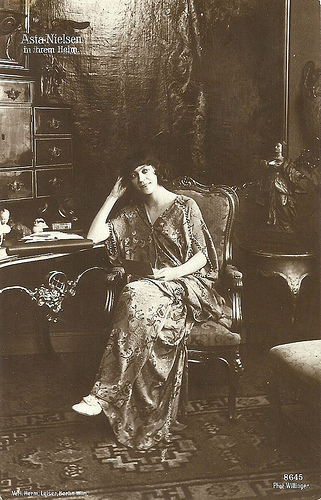
Asta Nielsen at home. German postcard by Verlag Hermann Leiser, Berlin-Wilmersdorf, no. 8645. Photo: Willinger.
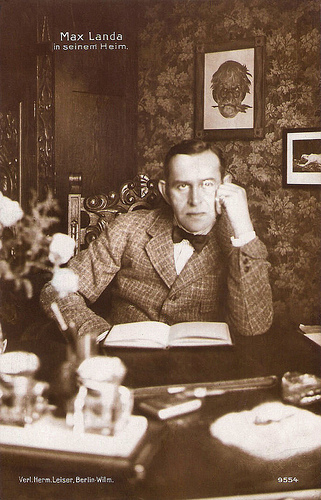
Max Landa at home. German postcard by Verlag Hermann Leiser, Berlin, no. 9554.
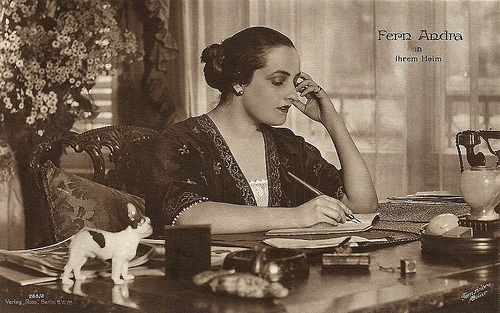
Fern Andra at her home. German postcard by Ross Verlag, Berlin, no. 288/2, 1919-1924. Photo: Fern Andra Atelier.
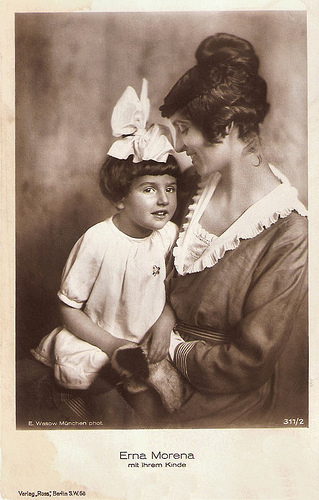
Erna Morena and her child. German postcard by Ross Verlag, Berlin, no.311/2, 1919-1924. Photo: Wasow, München (Munich).
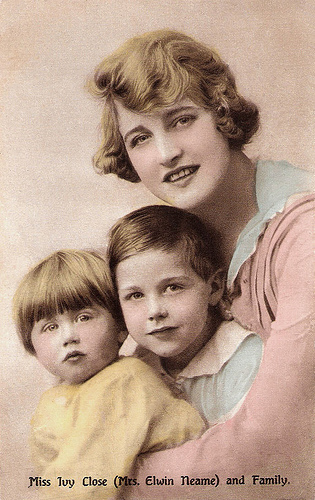
Ivy Close and her sons Derek and Ronald Neame. British postcard in the Philco (PPC) Series, no. 1070-3. Photo: Elwyn Neame.
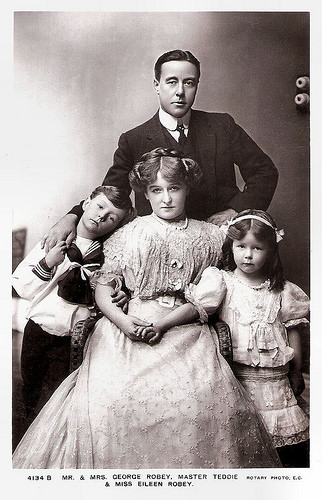
Mr. and Mrs. George Robey, Master Teddie & Miss Eileen Robey. British postcard by Rotary Photo EC., no. 4134 B.
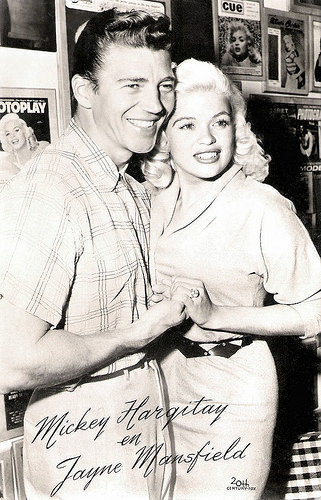
Husband Mickey Hargitay and wife Jayne Mansfield at home. Dutch postcard by Uitgeverij Takken, no. 3674. Photo: 20th Century Fox.
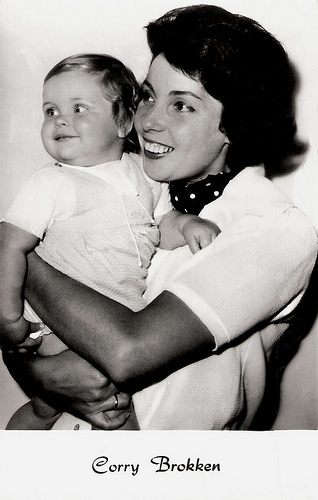
Dutch singer Corry Brokken with her only child, daughter Nancy, born in 1959.Dutch postcard by Gebr. Spanjersberg N.V., Rotterdam, no. 5625.
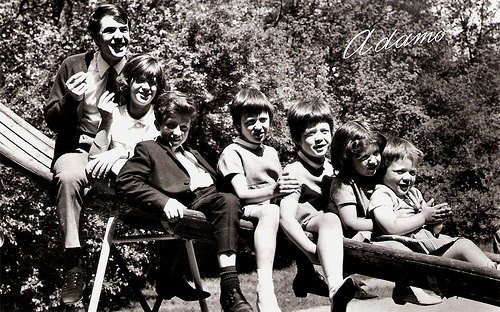
Italian-Belgian singer and actor Adamo with his many siblings. Dutch postcard by 't Sticht, Utrecht / Uitgeverij Takken, no. AX 5826. Photo: NV Bovema.
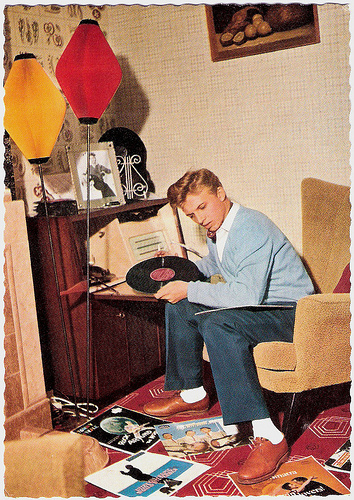
British teen idol Tommy Steele at home. German postcard by Ufa, Berlin-Tempelhof, no. CK 345. Photo: Dezo Hoffman / UFA.
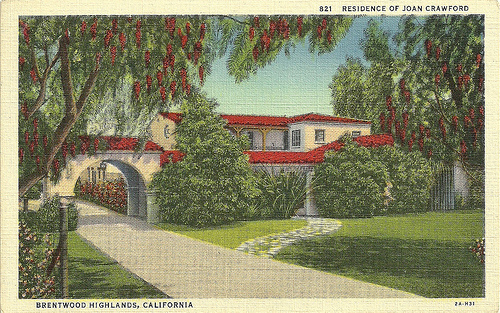
American postcard, no. 821. Residence of Joan Crawford, Brentwood, LA, California.
Crawford lived here between 1929 and 1956, at 426, North Bristol Avenue. The house was decorated by her friend Billy Haines.
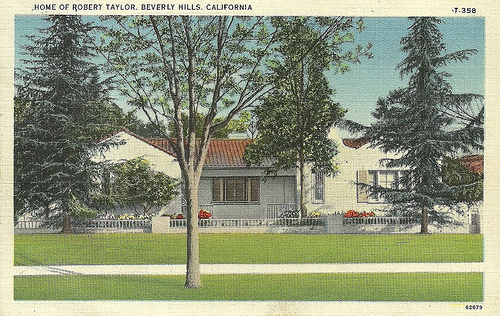
American postcard, no. 62679. Home of Robert Taylor, 510, Roxbury Drive, Beverly Hills, LA, California.
This is a post for Postcard Friendship Friday, hosted by Beth at the The Best Hearts are Crunchy. You can visit her by clicking on the button below.


Asta Nielsen at home. German postcard by Verlag Hermann Leiser, Berlin-Wilmersdorf, no. 8645. Photo: Willinger.

Max Landa at home. German postcard by Verlag Hermann Leiser, Berlin, no. 9554.

Fern Andra at her home. German postcard by Ross Verlag, Berlin, no. 288/2, 1919-1924. Photo: Fern Andra Atelier.

Erna Morena and her child. German postcard by Ross Verlag, Berlin, no.311/2, 1919-1924. Photo: Wasow, München (Munich).

Ivy Close and her sons Derek and Ronald Neame. British postcard in the Philco (PPC) Series, no. 1070-3. Photo: Elwyn Neame.

Mr. and Mrs. George Robey, Master Teddie & Miss Eileen Robey. British postcard by Rotary Photo EC., no. 4134 B.

Husband Mickey Hargitay and wife Jayne Mansfield at home. Dutch postcard by Uitgeverij Takken, no. 3674. Photo: 20th Century Fox.

Dutch singer Corry Brokken with her only child, daughter Nancy, born in 1959.Dutch postcard by Gebr. Spanjersberg N.V., Rotterdam, no. 5625.

Italian-Belgian singer and actor Adamo with his many siblings. Dutch postcard by 't Sticht, Utrecht / Uitgeverij Takken, no. AX 5826. Photo: NV Bovema.

British teen idol Tommy Steele at home. German postcard by Ufa, Berlin-Tempelhof, no. CK 345. Photo: Dezo Hoffman / UFA.

American postcard, no. 821. Residence of Joan Crawford, Brentwood, LA, California.
Crawford lived here between 1929 and 1956, at 426, North Bristol Avenue. The house was decorated by her friend Billy Haines.

American postcard, no. 62679. Home of Robert Taylor, 510, Roxbury Drive, Beverly Hills, LA, California.
This is a post for Postcard Friendship Friday, hosted by Beth at the The Best Hearts are Crunchy. You can visit her by clicking on the button below.

Published on October 27, 2016 22:00
October 26, 2016
Yvonne Monlaur
Yvonne Monlaur (1939) starred in several European film productions of the late 1950s and 1960s. The glamorous French starlet is best known for her roles in a few Hammer horror films.
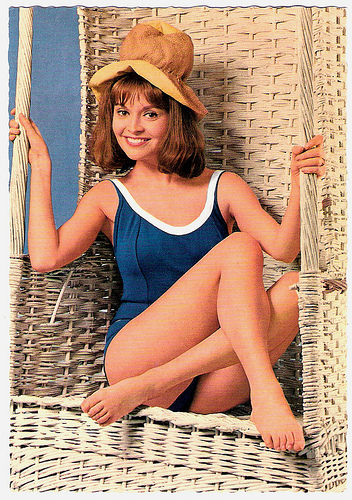
German postcard by Krüger, no. 902/395. Photo: Gérard Decaux.
The Year's Sexiest Screen Newcomer
Yvonne Monlaur was born Yvonne Bèdat de Monlaur in Pau, France in 1939. Her father was a White Russian count and her mother was a ballet dancer, who had great plans with her daughter. Yvonne followed her mother's footsteps and took ballerina lessons.
She eventually worked as a teenage model for magazines like Elle, when director André Hunebelle discovered her. He gave her small parts in his films Treize à table/Thirteen at the Table (André Hunebelle, 1955) with Micheline Presle , and Mannequins de Paris/Mannequins of Paris (André Hunebelle, 1956) starring Madeleine Robinson . She then had a supporting part in the Fernandel comedy Honoré de Marseille/Honoré from Marseille (Maurice Régamey, 1956).
Then Italian director Franco Rossi called her to Rome for the Italian-Spanish co-production Amore a prima vista/Love at First Sight (Franco Rossi, 1958) starring Walter Chiari . She appeared in more Italian films such as Non sono più Guaglione/I am not Guaglione anymore (Domenico Paolella, 1958) with Sylva Koscina , and Tre straniere a Roma/Three Strangers in Rome (Claudio Gora, 1958) with Claudia Cardinale in one of her first leading roles.
That year Monlaur was also spotted by the British producer Anthony Hinds. He asked to come to England to play in the an episode of the TV series Women in Love (1958) with George Sanders as the host.
In 1959 she suddenly seemed to be ‘hot’ all over Europe. In France a Paris magazine voted her the year's sexiest screen newcomer, in Great Britain she was featured with a four-page pictorial in the September issue of Male magazine and in Italy she is on the cover of a June issue of Tempo magazine and an Italian newspaper called her 'the year's most promising actress'. But during the shooting of the comedy Avventura a Capri/Adventure on Capri (Giuseppe Lipartiti, 1959) she had a serious accident. She suffered bad facial burns in a speedboat accident, resulting in months of recovery at a hospital.
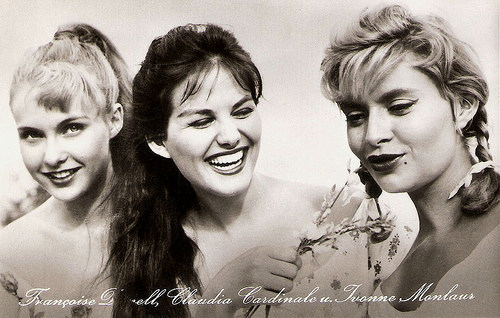
East-German postcard by VEB Progress Filmvertrieb, no. 1187, 1960. Publicity still for Tre straniere a Roma/Three Strangers in Rome (Claudio Gora, 1958) with Francoise Darnell, Claudia Cardinale and Yvonne Monlaur.
Hammer Horror
In 1960 Yvonne Monlaur travelled, accompanied by her mother, to England for a series of films. First she co-starred in the comedy Inn for Trouble (C.M. Pennington-Richards, 1960). Then followed the Hammer horror film The Brides of Dracula (Terence Fisher, 1960). She was introduced in the trailer as 'the latest sex kitten from France'.
Hal Erickson writes at AllMovie : “One of the best of the Hammer horrors, Brides of Dracula stars Peter Cushing as tireless vampire hunter Dr. Van Helsing. Though Drac himself doesn't make an appearance, his influence is felt thanks to teenaged bloodsucker Baron Meinster (David Peel). The baron's loving mother (Martita Hunt) shelters her son from harm, all the while scouring the countryside for potential female victims. When misguided schoolteacher Marianne (Yvonne Monlaur) falls in love with young Meinster, Van Helsing is forced to take drastic measures to show her the error of her ways. Excellent (and very bloody) special effects highlight this sumptuous production.”
In Circus of Horrors (Sidney Hayers, 1960), this time produced by Amalgamated studios, Monlaur appeared alongside Donald Pleasance and Anton Diffring as a deranged German plastic surgeon.
She played a Chinese lady in the Hammer production The Terror of the Tongs (Anthony Bushell, 1961) with Christopher Lee as the vicious leader of a Chinese Tong gang operating in 1910 Hong Kong. Hal Erickson describes it as “a gory, garishly colored melodrama written by Jimmy Sangster in the tradition of the Fu Manchu films.”
Back in Italy she had a small part in the romantic comedy It Started in Naples (Melville Shavelson, 1960) starring Clark Gable and Sophia Loren .
She continued to work in England too and appeared in Time to Remember (Charles Jarrett, 1962), one of a series of second feature films based on Edgar Wallace novels released in the UK between 1960 and 1965.
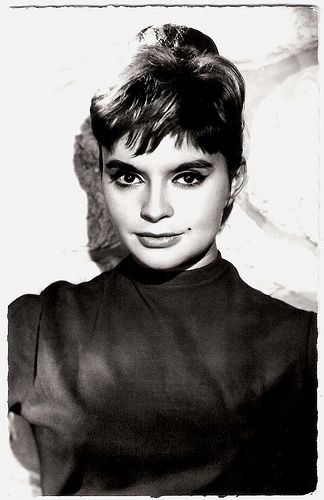
French postcard by Editions du Globe, no. 791. Photo: Studio Vauclair.
Lemmy Caution
In France Yvonne Monlaur played a supporting part in Lemmy pour les dames/Ladies’man (Bernard Borderie, 1962), one of the cult action films starring Eddie Constantine which were based on the crime novels by Peter Cheney.
She stayed in France for the crime comedy À cause, à cause d'une femme/Because of a Woman (Michel Deville, 1963) with Jacques Charrier and Mylène Demongeot , and the crime potboiler Le concerto de la peur/Night of Lust (José Bénazéraf, 1963) with a fabulous free-jazz score by Chet Baker.
The latter was a thriller about two rival mobsters who fight for control of the local drug traffic. The film also included a lesbian nightclub act, which was featured prominently on the international posters.
Monlaur then screentested for the role of Domino Derval in the James Bond film Thunderball (Terence Young, 1965). In his book The James Bond Films (1981), author Steven Jay Rubin features a picture of Monlaur posing in a 'Domino' bathing suit. The role eventually went to another French actress, Claudine Auger .
Yvonne Monlaurs moment seemed to be over. After the German crime thriller Die Rechnung - eiskalt serviert/Tip Not Included (Helmut Ashley, 1966) with George Nader as G-man Jerry Cotton, Monlaur left the cinema to return to France. Her last appearance was in the German TV series Der Tod läuft hinterher/The death runs behind (Wolfgang Becker, 1967) starring Joachim Fuchsberger .
Today Yvonne Monlaur lives in Paris and - now and then - she attends film conventions, which salute her Hammer films or her other Eurospy and action films. She also writes on her own official Yvonne Monlaur blog, on which she shares memories of her 1960s fantasy films, souvenirs of her career and confidences about her present activities.
Trailer for The Brides of Dracula (1960). Source: SuperNaturalEarth (YouTube).
Hammer Homage: The Terror of The Tongs (1961). Source: Time For Toast Productions (YouTube).
Sources: Yvonne Monlaur (Official blog), Hal Erickson (AllMovie), Cult Sirens, Glamour Girls of the Silver Screen, Wikipedia, and .

German postcard by Krüger, no. 902/395. Photo: Gérard Decaux.
The Year's Sexiest Screen Newcomer
Yvonne Monlaur was born Yvonne Bèdat de Monlaur in Pau, France in 1939. Her father was a White Russian count and her mother was a ballet dancer, who had great plans with her daughter. Yvonne followed her mother's footsteps and took ballerina lessons.
She eventually worked as a teenage model for magazines like Elle, when director André Hunebelle discovered her. He gave her small parts in his films Treize à table/Thirteen at the Table (André Hunebelle, 1955) with Micheline Presle , and Mannequins de Paris/Mannequins of Paris (André Hunebelle, 1956) starring Madeleine Robinson . She then had a supporting part in the Fernandel comedy Honoré de Marseille/Honoré from Marseille (Maurice Régamey, 1956).
Then Italian director Franco Rossi called her to Rome for the Italian-Spanish co-production Amore a prima vista/Love at First Sight (Franco Rossi, 1958) starring Walter Chiari . She appeared in more Italian films such as Non sono più Guaglione/I am not Guaglione anymore (Domenico Paolella, 1958) with Sylva Koscina , and Tre straniere a Roma/Three Strangers in Rome (Claudio Gora, 1958) with Claudia Cardinale in one of her first leading roles.
That year Monlaur was also spotted by the British producer Anthony Hinds. He asked to come to England to play in the an episode of the TV series Women in Love (1958) with George Sanders as the host.
In 1959 she suddenly seemed to be ‘hot’ all over Europe. In France a Paris magazine voted her the year's sexiest screen newcomer, in Great Britain she was featured with a four-page pictorial in the September issue of Male magazine and in Italy she is on the cover of a June issue of Tempo magazine and an Italian newspaper called her 'the year's most promising actress'. But during the shooting of the comedy Avventura a Capri/Adventure on Capri (Giuseppe Lipartiti, 1959) she had a serious accident. She suffered bad facial burns in a speedboat accident, resulting in months of recovery at a hospital.

East-German postcard by VEB Progress Filmvertrieb, no. 1187, 1960. Publicity still for Tre straniere a Roma/Three Strangers in Rome (Claudio Gora, 1958) with Francoise Darnell, Claudia Cardinale and Yvonne Monlaur.
Hammer Horror
In 1960 Yvonne Monlaur travelled, accompanied by her mother, to England for a series of films. First she co-starred in the comedy Inn for Trouble (C.M. Pennington-Richards, 1960). Then followed the Hammer horror film The Brides of Dracula (Terence Fisher, 1960). She was introduced in the trailer as 'the latest sex kitten from France'.
Hal Erickson writes at AllMovie : “One of the best of the Hammer horrors, Brides of Dracula stars Peter Cushing as tireless vampire hunter Dr. Van Helsing. Though Drac himself doesn't make an appearance, his influence is felt thanks to teenaged bloodsucker Baron Meinster (David Peel). The baron's loving mother (Martita Hunt) shelters her son from harm, all the while scouring the countryside for potential female victims. When misguided schoolteacher Marianne (Yvonne Monlaur) falls in love with young Meinster, Van Helsing is forced to take drastic measures to show her the error of her ways. Excellent (and very bloody) special effects highlight this sumptuous production.”
In Circus of Horrors (Sidney Hayers, 1960), this time produced by Amalgamated studios, Monlaur appeared alongside Donald Pleasance and Anton Diffring as a deranged German plastic surgeon.
She played a Chinese lady in the Hammer production The Terror of the Tongs (Anthony Bushell, 1961) with Christopher Lee as the vicious leader of a Chinese Tong gang operating in 1910 Hong Kong. Hal Erickson describes it as “a gory, garishly colored melodrama written by Jimmy Sangster in the tradition of the Fu Manchu films.”
Back in Italy she had a small part in the romantic comedy It Started in Naples (Melville Shavelson, 1960) starring Clark Gable and Sophia Loren .
She continued to work in England too and appeared in Time to Remember (Charles Jarrett, 1962), one of a series of second feature films based on Edgar Wallace novels released in the UK between 1960 and 1965.

French postcard by Editions du Globe, no. 791. Photo: Studio Vauclair.
Lemmy Caution
In France Yvonne Monlaur played a supporting part in Lemmy pour les dames/Ladies’man (Bernard Borderie, 1962), one of the cult action films starring Eddie Constantine which were based on the crime novels by Peter Cheney.
She stayed in France for the crime comedy À cause, à cause d'une femme/Because of a Woman (Michel Deville, 1963) with Jacques Charrier and Mylène Demongeot , and the crime potboiler Le concerto de la peur/Night of Lust (José Bénazéraf, 1963) with a fabulous free-jazz score by Chet Baker.
The latter was a thriller about two rival mobsters who fight for control of the local drug traffic. The film also included a lesbian nightclub act, which was featured prominently on the international posters.
Monlaur then screentested for the role of Domino Derval in the James Bond film Thunderball (Terence Young, 1965). In his book The James Bond Films (1981), author Steven Jay Rubin features a picture of Monlaur posing in a 'Domino' bathing suit. The role eventually went to another French actress, Claudine Auger .
Yvonne Monlaurs moment seemed to be over. After the German crime thriller Die Rechnung - eiskalt serviert/Tip Not Included (Helmut Ashley, 1966) with George Nader as G-man Jerry Cotton, Monlaur left the cinema to return to France. Her last appearance was in the German TV series Der Tod läuft hinterher/The death runs behind (Wolfgang Becker, 1967) starring Joachim Fuchsberger .
Today Yvonne Monlaur lives in Paris and - now and then - she attends film conventions, which salute her Hammer films or her other Eurospy and action films. She also writes on her own official Yvonne Monlaur blog, on which she shares memories of her 1960s fantasy films, souvenirs of her career and confidences about her present activities.
Trailer for The Brides of Dracula (1960). Source: SuperNaturalEarth (YouTube).
Hammer Homage: The Terror of The Tongs (1961). Source: Time For Toast Productions (YouTube).
Sources: Yvonne Monlaur (Official blog), Hal Erickson (AllMovie), Cult Sirens, Glamour Girls of the Silver Screen, Wikipedia, and .
Published on October 26, 2016 22:00
October 25, 2016
Ihr Sport (1919)
Henny Porten (1890-1960) was one of Germany's most important and popular film actresses of the silent cinema. She appeared both as the tragic heroin in many dramas and as the zany girl in comedies. We love the images of the postcards produced for her comedy Ihr Sport/Her Sport (Rudolf Biebrach, 1919).
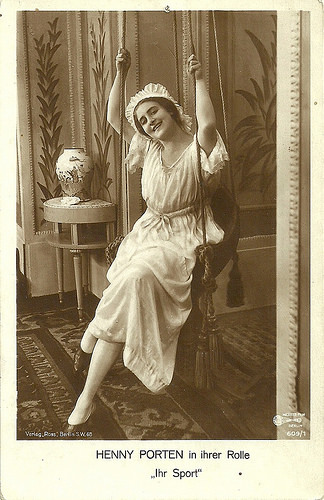
German postcard by Ross Verlag, no. 609/1. Photo: Messter Film, Berlin. Publicity still of Henny Porten in the German silent film Ihr Sport (1919).
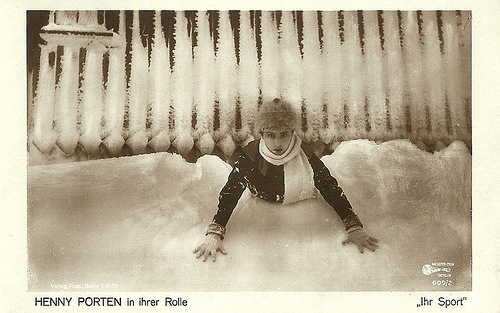
German postcard by Ross Verlag, no. 609/2. Photo: Messter Film, Berlin. Publicity still of Henny Porten in the German silent film Ihr Sport (1919).
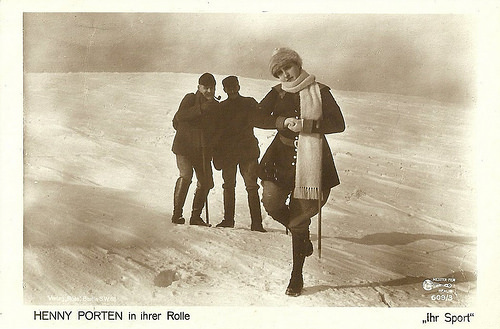
German postcard by Ross Verlag, no. 609/3. Photo: Messter Film, Berlin. Publicity still of Henny Porten in the German silent film Ihr Sport (1919).
The Man Hater
Henny Porten plays in Ihr Sport/Her Sport (Rudolf Biebrach, 1919) Adelina von Gentz, known as 'Männerfresserin' (man hater) .
When her friend Helga (Wally Koch) is about to marry old-fashioned Rudolf Walters (George Schnell), Adelina writes Helga to rebel against her new husband.
On their honeymoon the newly married couple travel to the Silesian Karpates where Adelina lives. Upon their arrival, the couple is at odds with each other.
This is the ideal condition for Adelina to try to break up her friend's new marriage. She disguises herself as a maid and assumes a position in the hotel where the couple Walters has descended. She wants to tease Helga's husband.
In the hotel, Adelina meets namesake Rudi Walters ( Hermann Thimig ), who causes Adelina to quickly cast aside her hostile attitude towards men. At the end of the film, Adelina has not only found love, but has also reconciled Helga and her husband.
As the shooting in the snow proves, Ihr Sport was shot in early 1919, immediately after the shooting of the Porten film Irrungen. The script was written by Robert Wiene, cinematography was by Willibald Gaebel, and the sets were designed by Ludwig Kainer. Actress Wally Koch (Helga) also edited the film.
The film passed censorship in March 1919, but was forbidden for young people. Ihr Sport premiered at the Berlin Mozartsaal cinema on 12 April 1919. In the weekly Austrian film programme Paimann’s Filmlisten, Franz Paimann wrote about the film: "Humor very good. Cinematography, acting and sets excellent."
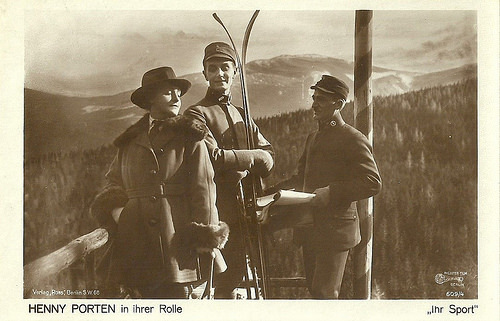
German postcard by Ross Verlag, no. 609/4. Photo: Messter Film, Berlin. Publicity still of Henny Porten in the German silent film Ihr Sport (1919).
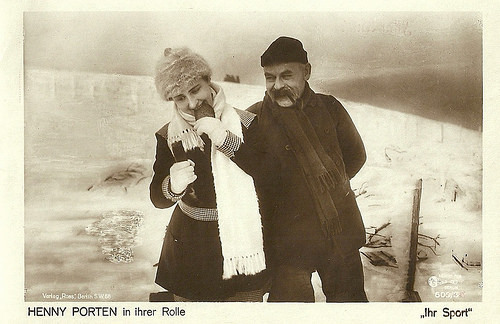
German postcard by Ross Verlag, no. 609/5. Photo: Messter Film, Berlin. Publicity still of Henny Porten in the German silent film Ihr Sport (1919).
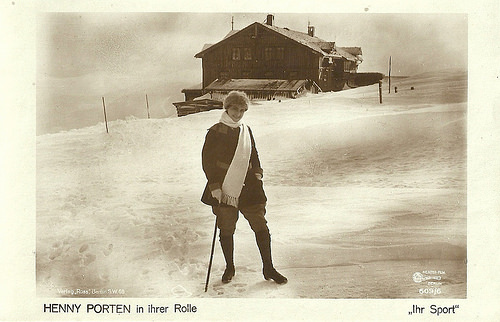
German postcard by Ross Verlag, no. 609/6. Photo: Messter Film, Berlin. Publicity still of Henny Porten in the German silent film Ihr Sport (1919).
Sources: Wikipedia (German and English) and IMDb.

German postcard by Ross Verlag, no. 609/1. Photo: Messter Film, Berlin. Publicity still of Henny Porten in the German silent film Ihr Sport (1919).

German postcard by Ross Verlag, no. 609/2. Photo: Messter Film, Berlin. Publicity still of Henny Porten in the German silent film Ihr Sport (1919).

German postcard by Ross Verlag, no. 609/3. Photo: Messter Film, Berlin. Publicity still of Henny Porten in the German silent film Ihr Sport (1919).
The Man Hater
Henny Porten plays in Ihr Sport/Her Sport (Rudolf Biebrach, 1919) Adelina von Gentz, known as 'Männerfresserin' (man hater) .
When her friend Helga (Wally Koch) is about to marry old-fashioned Rudolf Walters (George Schnell), Adelina writes Helga to rebel against her new husband.
On their honeymoon the newly married couple travel to the Silesian Karpates where Adelina lives. Upon their arrival, the couple is at odds with each other.
This is the ideal condition for Adelina to try to break up her friend's new marriage. She disguises herself as a maid and assumes a position in the hotel where the couple Walters has descended. She wants to tease Helga's husband.
In the hotel, Adelina meets namesake Rudi Walters ( Hermann Thimig ), who causes Adelina to quickly cast aside her hostile attitude towards men. At the end of the film, Adelina has not only found love, but has also reconciled Helga and her husband.
As the shooting in the snow proves, Ihr Sport was shot in early 1919, immediately after the shooting of the Porten film Irrungen. The script was written by Robert Wiene, cinematography was by Willibald Gaebel, and the sets were designed by Ludwig Kainer. Actress Wally Koch (Helga) also edited the film.
The film passed censorship in March 1919, but was forbidden for young people. Ihr Sport premiered at the Berlin Mozartsaal cinema on 12 April 1919. In the weekly Austrian film programme Paimann’s Filmlisten, Franz Paimann wrote about the film: "Humor very good. Cinematography, acting and sets excellent."

German postcard by Ross Verlag, no. 609/4. Photo: Messter Film, Berlin. Publicity still of Henny Porten in the German silent film Ihr Sport (1919).

German postcard by Ross Verlag, no. 609/5. Photo: Messter Film, Berlin. Publicity still of Henny Porten in the German silent film Ihr Sport (1919).

German postcard by Ross Verlag, no. 609/6. Photo: Messter Film, Berlin. Publicity still of Henny Porten in the German silent film Ihr Sport (1919).
Sources: Wikipedia (German and English) and IMDb.
Published on October 25, 2016 22:00
October 24, 2016
Heinrich Peer
Austrian stage and film actor Heinrich Peer (1867–1927) belonged to the pioneers of the German cinema and appeared in more than hundred films between 1911 and 1927. The tall, thin actor with the distinctive, almost sinister face often played supporting parts in adventure and detective films, but also played in melodramas and historical films.
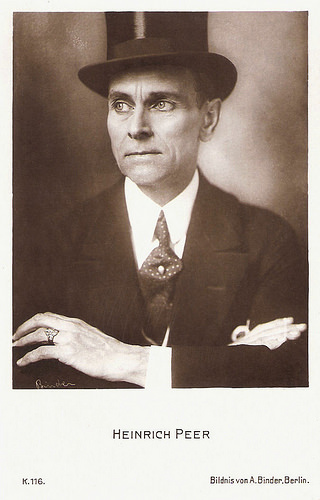
German postcard by NPG. no. K 116. Photo: Alex Binder, Berlin.
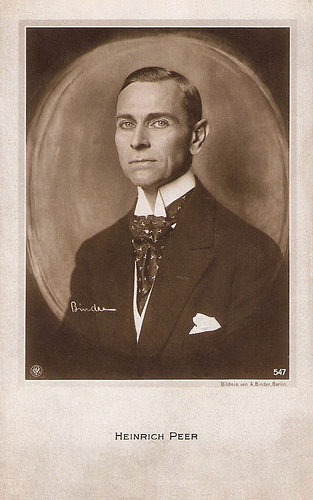
German postcard by NPG. no. 547. Photo: Alex Binder, Berlin.
The famous sleuth Harry Reep
Heinrich Friedrich Peer was born in Vienna, Austro-Hungarian Empire, in 1867. He began his stage career at the Raimundtheater in Vienna and from 1892 on, he played in a theatre in Esseg (now Osijek, Croatia). After stopovers in Innsbruck and Pressburg (now Bratislava, Slovakia), he made his Berlin debut in 1902 at the Intimen Theater.
Heinrich Peer often appeared in operettas, especially at the Theater des Westens. There he played leading roles in Oscar Straus' Ein Walzertraum (A Waltz Dream) and Franz Lehár’s Die lustige Witwe (The Merry Widow).
Already in 1911, he made his film debut. That year he played in the short silent melodrama Nachtfalter/Moth (Urban Gad, 1911), which was only the second German film with Danish diva Asta Nielsen . The shooting took place in Bioscope-Atelier Chausseestrasse in Berlin, a studio with glass walls and artificial lighting with electric light. The silent film is now considered lost, like many other films of this period.
Peer also played in the silent short Mutters Todestag/Mother’s death (Adolf Gärtner, 1911) for the Messter studio. Peer then appeared for the Vitascope studio in the very popular detective comedy Wo ist Coletti?/Where is Coletti? (Max Mack, 1913), featuring Hans Junkermann, and in the comedy Die blaue Maus/The Blue Mouse (Max Mack, 1913), featuring Fritzi Lustig.
Peer also played a count in Der Geheimsekretär/The private secretary (Joe May, 1915), a part in another popular crime series about detective Joe Deeb played by Max Landa . He next played the best friend of the title figure in the comedy Hampels Abenteuer/Hampel's Adventure (Richard Oswald, 1915) with Georg Baselt as Hampel and a supporting part in Schlemihl (Richard Oswald, 1915) starring Rudolph Schildkraut and his son Joseph Schildkraut.
Peer also appeared in dramas such as Die Ruf der Liebe/The call of love (Rudolf Biebrach, 1916) with Henny Porten, and Die Liebe der Hetty Raymond/The love of Hetty Raymond (Joe May, 1917), featuring Mia May .
In the late 1910s, Peer now and then played leading roles, such as in Im stillen Ozean/In the Silent Ocean (Danny Kaden, 1917). He played the famous sleuth Harry Reep in Eine Nacht in der Stahlkammer/A night at the vault (Felix Basch, 1917) with Harry Liedtke as a shameless bank director, and Leopoldine Konstantin as his accomplice.
In 1918, he played an English officer in Ernst Lubitsch ´s silent drama Carmen (Ernst Lubitsch, 1918), which established the stardom of actress Pola Negri . Carmen was based on the novella by Prosper Mérimée. Peer played another detective, Council Anheim, in a fairly short-lived detective series, including Der grüne Vampyr/The green Vampire (William Kahn, 1918). This crime film with horror elements was one of the first films that brought vampirism on the screen.
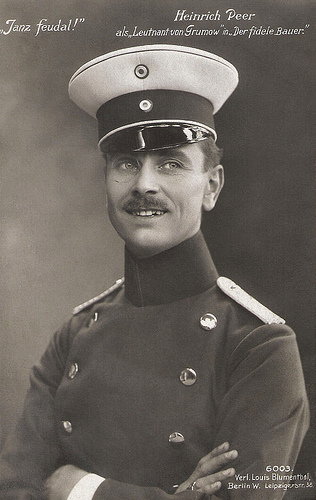
German postcard by Verlag Louis Blumenthal, Berlin, no. 6003. Caption: `Janz feudal! Heinrich Peer als Leutnant von Grumow in Der fidele Bauer.` Der fidele Bauer (The Merry Farmer) is a 1907 German-language operetta composed by Leo Fall with a libretto by Viktor Léon. It premiered at the Mannheim Hoftheater on 27 July 1907 and was Fall's first major hit.
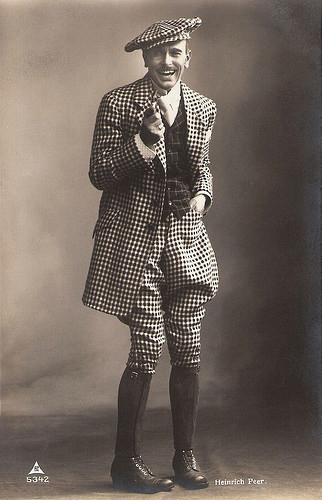
German postcard by Pm. no. 5342.
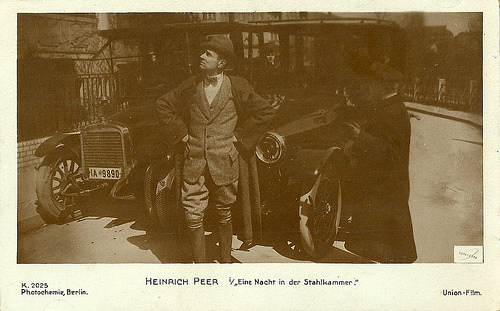
German postcard by Photochemie, Berlin, no. K.2025. Photo: Union Film. Heinrich Peer in the German silent film Eine Nacht in der Stahlkammer/A night in the tack room (Felix Basch, 1917).
Premature end
During the early 1920s, Heinrich Peer was often cast opposite Lya Mara by director Friedrich a.k.a. Frederic Zelnik , such as in the Tolstoi adaptation Anna Karenina (1920), and in Die Tochter Napoleons/Napoleon’s Daughter (1922).
Peer had supporting roles in such German silent films as the comedy Die Geliebte des Grafen Varenne/Count Varenne's Lover (Friedrich Zelnik, 1921) again opposite Lya Mara , Graf Festenberg/Count Festenberg (Urban Gad, Friedrich Zelnik, 1922) starring Charles Willy Kayser, and the drama Der Evangelimann/The Evangelist (Holger-Madsen, 1924) starring Paul Hartmann .
In 1925, Heinrich Peer had another supporting part in the silent historical film Bismarck (Ernst Wendt, 1925). It portrays the life of the nineteenth century German Chancellor Otto Von Bismarck (Franz Ludwig) and was part of a popular trend of Prussian films released in Germany after the First World War.
Bismarck was followed by a second film, Bismarck 1862-1898 (Kurt Blachy, 1927), also starring Ludwig and with Peer again as an Austrian diplomat. In between, Peer appeared in another Prussian film, Die Mühle von Sanssouci/The Mill at Sanssouci (Siegfried Philippi, Frederic Zelnik, 1926) about an episode in the life of the Prussian king Friedrich II ( Otto Gebühr ), the construction in the 18th Century of the historic mill of Sanssouci. Peer played the king’s chamberlain.
In 1927, Heinrich Peer suddenly died in Vienna, Austria. He was 59. Peer was married to actress Bella Friese. Thomas Staedeli at Cyranos : “his career was ended premature, a career which would have certainly continued in a great way in the 30's.”
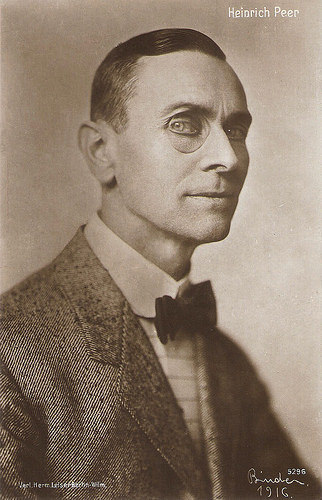
German postcard by Verlag Hermann Leiser, Berlin. no. 5296. Photo: Alex Binder, Berlin, 1916.
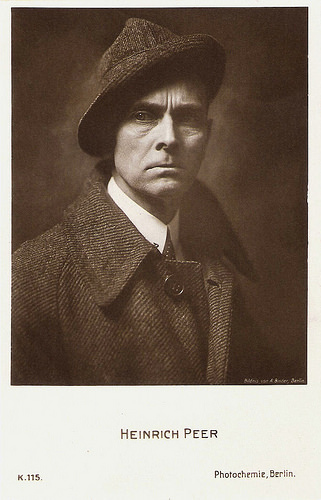
German postcard by Photochemie, Berlin. no. K. 115. Photo: Alex Binder, Berlin.
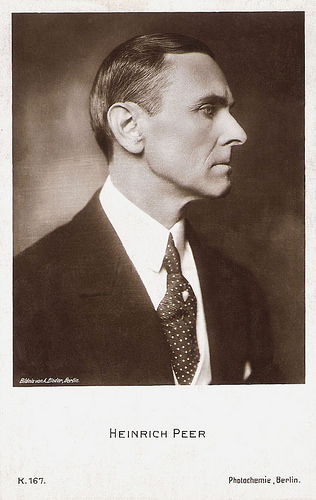
German postcard by Photochemie, Berlin, no. K. 167. Photo: Alex Binder.
Sources: Thomas Staedeli (Cyranos), Stephanie D’heil (Steffi-Line – German), Filmportal,de, Wikipedia (English and German) and .

German postcard by NPG. no. K 116. Photo: Alex Binder, Berlin.

German postcard by NPG. no. 547. Photo: Alex Binder, Berlin.
The famous sleuth Harry Reep
Heinrich Friedrich Peer was born in Vienna, Austro-Hungarian Empire, in 1867. He began his stage career at the Raimundtheater in Vienna and from 1892 on, he played in a theatre in Esseg (now Osijek, Croatia). After stopovers in Innsbruck and Pressburg (now Bratislava, Slovakia), he made his Berlin debut in 1902 at the Intimen Theater.
Heinrich Peer often appeared in operettas, especially at the Theater des Westens. There he played leading roles in Oscar Straus' Ein Walzertraum (A Waltz Dream) and Franz Lehár’s Die lustige Witwe (The Merry Widow).
Already in 1911, he made his film debut. That year he played in the short silent melodrama Nachtfalter/Moth (Urban Gad, 1911), which was only the second German film with Danish diva Asta Nielsen . The shooting took place in Bioscope-Atelier Chausseestrasse in Berlin, a studio with glass walls and artificial lighting with electric light. The silent film is now considered lost, like many other films of this period.
Peer also played in the silent short Mutters Todestag/Mother’s death (Adolf Gärtner, 1911) for the Messter studio. Peer then appeared for the Vitascope studio in the very popular detective comedy Wo ist Coletti?/Where is Coletti? (Max Mack, 1913), featuring Hans Junkermann, and in the comedy Die blaue Maus/The Blue Mouse (Max Mack, 1913), featuring Fritzi Lustig.
Peer also played a count in Der Geheimsekretär/The private secretary (Joe May, 1915), a part in another popular crime series about detective Joe Deeb played by Max Landa . He next played the best friend of the title figure in the comedy Hampels Abenteuer/Hampel's Adventure (Richard Oswald, 1915) with Georg Baselt as Hampel and a supporting part in Schlemihl (Richard Oswald, 1915) starring Rudolph Schildkraut and his son Joseph Schildkraut.
Peer also appeared in dramas such as Die Ruf der Liebe/The call of love (Rudolf Biebrach, 1916) with Henny Porten, and Die Liebe der Hetty Raymond/The love of Hetty Raymond (Joe May, 1917), featuring Mia May .
In the late 1910s, Peer now and then played leading roles, such as in Im stillen Ozean/In the Silent Ocean (Danny Kaden, 1917). He played the famous sleuth Harry Reep in Eine Nacht in der Stahlkammer/A night at the vault (Felix Basch, 1917) with Harry Liedtke as a shameless bank director, and Leopoldine Konstantin as his accomplice.
In 1918, he played an English officer in Ernst Lubitsch ´s silent drama Carmen (Ernst Lubitsch, 1918), which established the stardom of actress Pola Negri . Carmen was based on the novella by Prosper Mérimée. Peer played another detective, Council Anheim, in a fairly short-lived detective series, including Der grüne Vampyr/The green Vampire (William Kahn, 1918). This crime film with horror elements was one of the first films that brought vampirism on the screen.

German postcard by Verlag Louis Blumenthal, Berlin, no. 6003. Caption: `Janz feudal! Heinrich Peer als Leutnant von Grumow in Der fidele Bauer.` Der fidele Bauer (The Merry Farmer) is a 1907 German-language operetta composed by Leo Fall with a libretto by Viktor Léon. It premiered at the Mannheim Hoftheater on 27 July 1907 and was Fall's first major hit.

German postcard by Pm. no. 5342.

German postcard by Photochemie, Berlin, no. K.2025. Photo: Union Film. Heinrich Peer in the German silent film Eine Nacht in der Stahlkammer/A night in the tack room (Felix Basch, 1917).
Premature end
During the early 1920s, Heinrich Peer was often cast opposite Lya Mara by director Friedrich a.k.a. Frederic Zelnik , such as in the Tolstoi adaptation Anna Karenina (1920), and in Die Tochter Napoleons/Napoleon’s Daughter (1922).
Peer had supporting roles in such German silent films as the comedy Die Geliebte des Grafen Varenne/Count Varenne's Lover (Friedrich Zelnik, 1921) again opposite Lya Mara , Graf Festenberg/Count Festenberg (Urban Gad, Friedrich Zelnik, 1922) starring Charles Willy Kayser, and the drama Der Evangelimann/The Evangelist (Holger-Madsen, 1924) starring Paul Hartmann .
In 1925, Heinrich Peer had another supporting part in the silent historical film Bismarck (Ernst Wendt, 1925). It portrays the life of the nineteenth century German Chancellor Otto Von Bismarck (Franz Ludwig) and was part of a popular trend of Prussian films released in Germany after the First World War.
Bismarck was followed by a second film, Bismarck 1862-1898 (Kurt Blachy, 1927), also starring Ludwig and with Peer again as an Austrian diplomat. In between, Peer appeared in another Prussian film, Die Mühle von Sanssouci/The Mill at Sanssouci (Siegfried Philippi, Frederic Zelnik, 1926) about an episode in the life of the Prussian king Friedrich II ( Otto Gebühr ), the construction in the 18th Century of the historic mill of Sanssouci. Peer played the king’s chamberlain.
In 1927, Heinrich Peer suddenly died in Vienna, Austria. He was 59. Peer was married to actress Bella Friese. Thomas Staedeli at Cyranos : “his career was ended premature, a career which would have certainly continued in a great way in the 30's.”

German postcard by Verlag Hermann Leiser, Berlin. no. 5296. Photo: Alex Binder, Berlin, 1916.

German postcard by Photochemie, Berlin. no. K. 115. Photo: Alex Binder, Berlin.

German postcard by Photochemie, Berlin, no. K. 167. Photo: Alex Binder.
Sources: Thomas Staedeli (Cyranos), Stephanie D’heil (Steffi-Line – German), Filmportal,de, Wikipedia (English and German) and .
Published on October 24, 2016 22:00
October 23, 2016
Jacques Brel
Belgian singer-songwriter Jacques Brel (1929-1978) was one of the most important and influential representatives of the French chanson. At the height of his success, in 1966, he chose to stop singing to devote himself to theatre and cinema. Brel has sold over 25 million records worldwide. There have been at least 400 recorded versions of his song Ne me quitte pas/If You Go Away, in over 15 different languages by performers like Marlene Dietrich, Rod McKuen, Nana Mouskouri, Nina Simone and Sting. Seasons in the Sun, Terry Jacks' version of Le Moribond , became a global pop hit in 1974. Brel’s boundless enthusiasm towards life, his inexhaustible energy and his respect for ordinary people remain unforgettable.
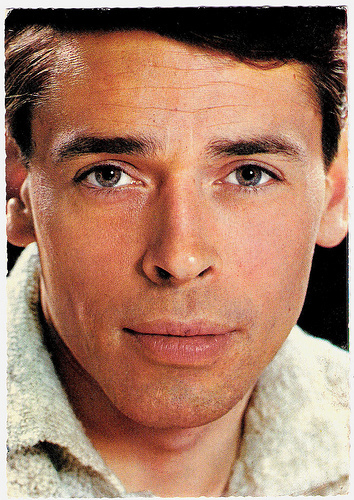
French postcard by E.D.U.G., no. 262. Photo: Herman Léonard.
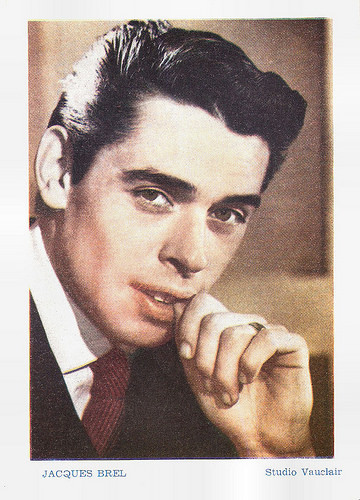
Belgian collectors card by Merbotex, Brussels for Cine Memlinc. Photo: Studio Vauclair.
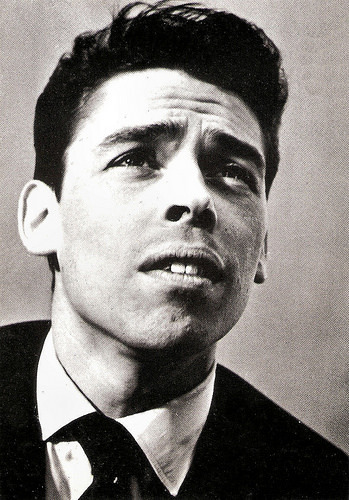
French postcard by Editions P.I., Paris, no. 36.
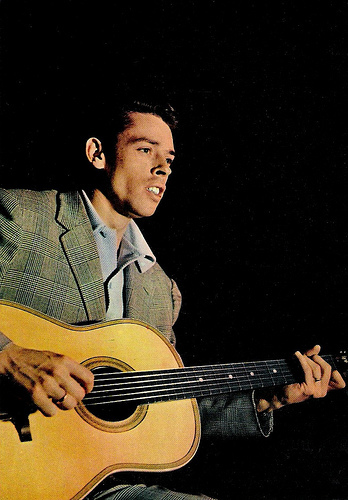
Dutch postcard by Uitgeverij Syba, Enkhuizen. Promotional postcard for Philips records. Sent by mail in 1963.
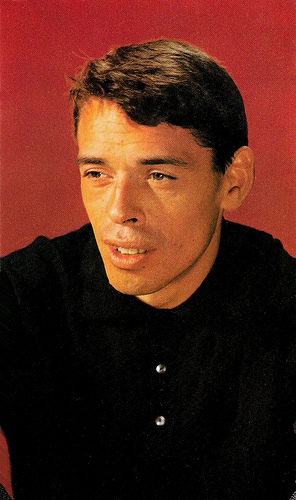
French postcard by PSG, no. 263. Offered by Corvisart, Epinal. Photo: Sam Lévin.
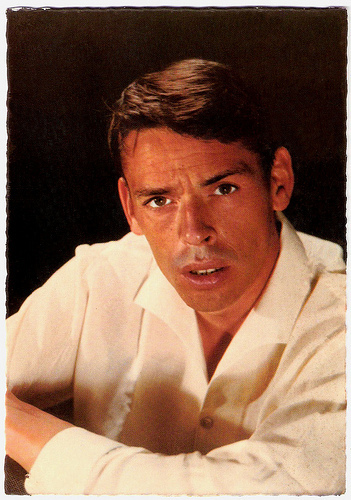
French postcard by E.D.U.G., Paris, no. 179. Photo: Sam Lévin.
Catholic-humanist Troubadour
Jacques Romain Georges Brel was born in 1929 in Schaarbeek, a district of Brussels, Belgium. Brel was the son of Romain Brel, who worked in an import-export firm, but later became co-director of a company that manufactured cardboard cartons, and Elisabeth (Lambertine) Brel. Although the Brel family spoke French, they were of Flemish descent, with some of the family originating from Zandvoorde, near Ieper (Ypres).
After quitting school, Jacques started his working life at his father's cardboard factory, apparently destined to follow his father's footsteps. However, he showed an interest in culture, and began playing the guitar at the age of 15. He joined the Catholic-humanist youth organisation Franche Cordée, which organised concerts and shows and Brel began to sing in public, accompanying himself on the guitar. Here he met Thérèse Michielsen ('Miche') who was to become his wife in 1950. A year later, their first daughter, Chantal, was born. Two years later, daughter France was born.
In the early 1950s, Brel achieved minor success in Belgium singing his own songs. In 1953, Jacques Canetti, a talent scout and artistic director with Philips, invited him to come to Paris. A 78 record, La foire/Il y a, was released, which sold 200 copies. Brel carried on writing music and singing in cabarets and music-halls, where he delivered his songs with great energy. He also went on stage at the famous Olympia theatre, as a supporting act.
Juliette Gréco made a recording of his song Ca va, le Diable. Brel did his first French tour, and at the end of 1954 Philips released his debut album, Jacques Brel et Ses Chansons. By 1956 he was touring Europe and he recorded the song Quand on n'a que l'amour (later adapted into English as If We Only Have Love) that brought him his first major recognition and reached number three in the French charts.
He made his film début in the title role of the short La Grande Peur de Monsieur Clément/The Big Fear of Mr. Clément (Paul Diebens, 1956), which he also co-wrote. With his career taking off, his wife and daughters joined him in Paris in February 1958. In August, his third daughter, Isabelle, was born, but by the end of the 1950s Miche and Brel's three daughters had returned to Brussels, while Jacques was always on tour.
From then on he and his family led separate lives. Under the influence of his friend Georges Pasquier ('Jojo') and pianists Gérard Jouannest and Francois Rauber, Brel's style changed. He was no longer a Catholic-humanist troubadour, but sang grimmer songs about love, death, and the struggle that is life. The music became more complex and his themes more diverse, exploring love, society, and spiritual concerns.
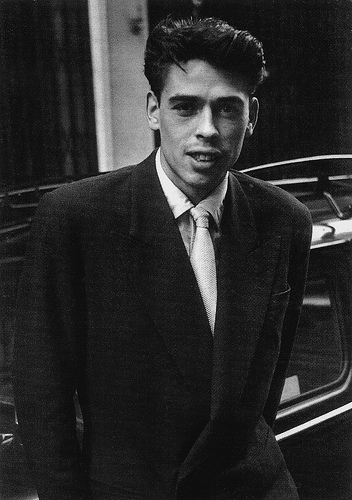
French postcard in the series Portraits de Stars - Chanteurs Français by L'Aventure Carto, no. 2. Photo: Marcel Thomas Collection Gérard Gagnepain. This postcard was printed in an edition of 120 cards.
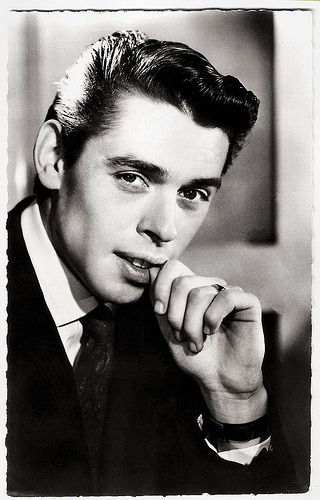
French postcard by Edition du Globe, Paris, no. 782. Photo: Studio Vauclair.
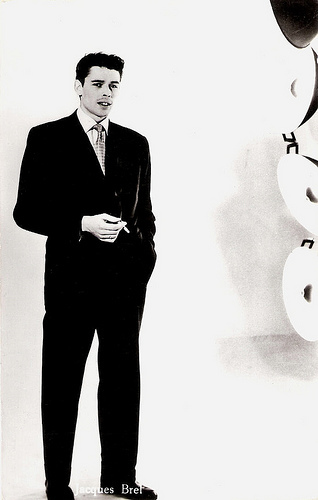
Dutch postcard by Hercules, Haarlem, no. 862.
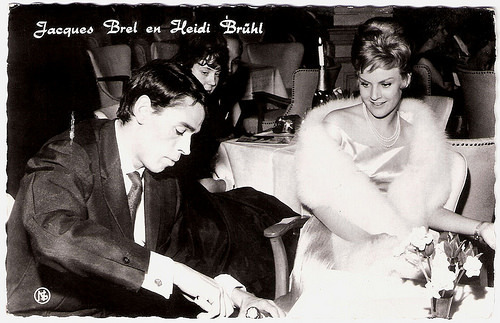
Dutch postcard by NS, no. 12. With Heidi Brühl.
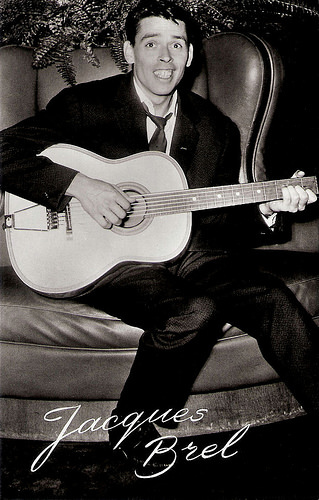
French postcard by Uitg. Takken, Utrecht, no. AX 4421.
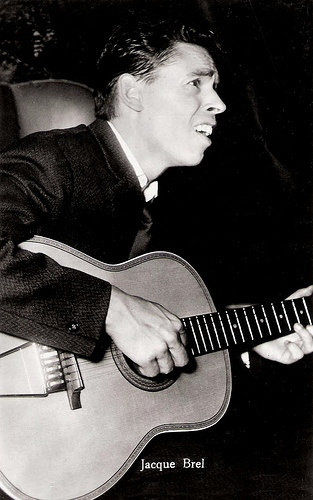
Dutch postcard by Gebr. Spanjersberg (SPARO), Rotterdam, no. 892.
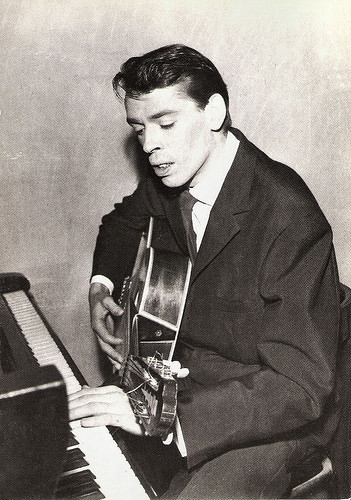
French postcard by Humour à la Carte, Paris, no. 3393. Photo: J.L. Rancurel.
Darkness and Bitter Irony
Jacques Brel was in 1961 contracted by Bruno Coquatrix, director of l'Olympia. Marlène Dietrich had pulled out from a series of shows at the very last moment. Coquatrix wanted Brel to replace her. October 12 to 29, Jacques Brel had star billing at the Olympia for the first time. In 1962 Brel signed with a new record company, the recently formed Barclay Records. Together with his wife, he also founded a publishing company, Editions Musicales Pouchenel.
During the 1960s, Brel was almost constantly on tour. He performed on all the famous stages in the world, including Estrade Theatre in Moscow and Carnegie Hall in New York, where he made his U.S. performing début in 1963. American poet and singer Rod McKuen began writing English lyrics to Brel's songs, and the Kingston Trio recorded Seasons in the Sun, McKuen's version of a song Brel had titled Le Moribond, on their Time to Think LP in 1964.
Brel's romantic lyricism now sometimes revealed darkness and bitter irony. At moments his tender love songs might show flashes of barely suppressed frustration and resentment. His insightful and compassionate portraits of the so-called dregs of society: the alcoholics, drifters, drug addicts, and prostitutes described in L’Ivrogne, Jef, La chanson de Jacky and Amsterdam evaded easy sentimentality, and he was not shy about portraying the unsavoury side of this lifestyle.
On stage, Brel gave additional dimensions to many of his songs, thanks to a strong theatrical sense and an apparently boundless energy. Brel’s appearance at Carnegie Hall in 1965 inspired a musical revue created by composer Mort Schuman and poet Eric Blau. Jacques Brel Is Alive and Well and Living in Paris featured 25 songs by Brel translated into English. The piece ran for five years in New York and played in a number of countries including Great Britain, Canada, South Africa and Sweden.
Brel occasionally included parts in Dutch in his songs as in Marieke, and also recorded Dutch versions of a few songs such as Le Plat Pays (Mijn vlakke land) and Ne me quitte pas (Laat Me Niet Alleen. Brel's attitude towards the Flemish was marked by a love of Flanders and the Flemish countryside, but a marked dislike of the Flemish nationalists ('les Flamingants').
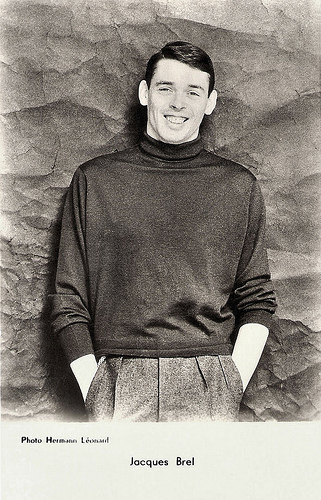
French postcard by Edition P.I., Paris, offered by Les Carbones Korès 'Carboplane', no. 1147A. Photo: Hermann Léonard.
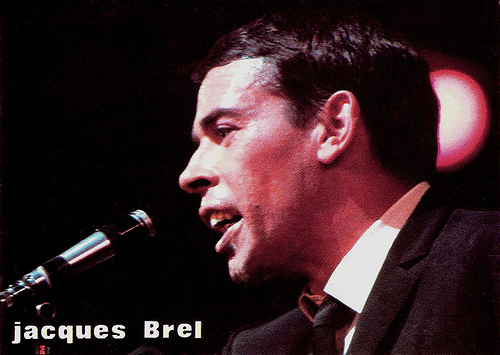
French postcard by Sofraneme, Levallois Perret, no. R 43.
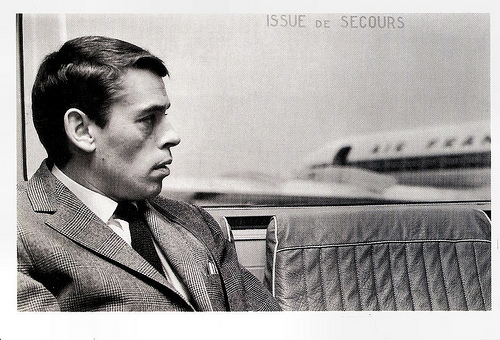
French postcard by Editions F. Nugeron, Star 134. Photo: Air France / Distribution VU. Caption: Jacques Brel, 20 Novembre 1964.
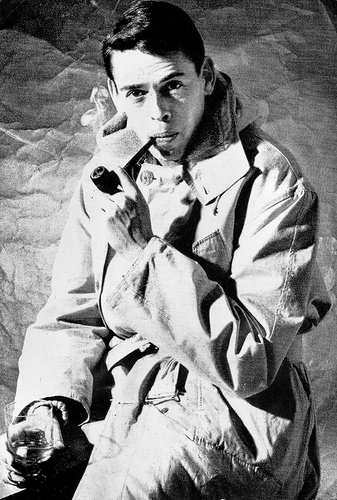
Dutch promotion card by N.V. Dureco, Amsterdam. Photo: Barclay.
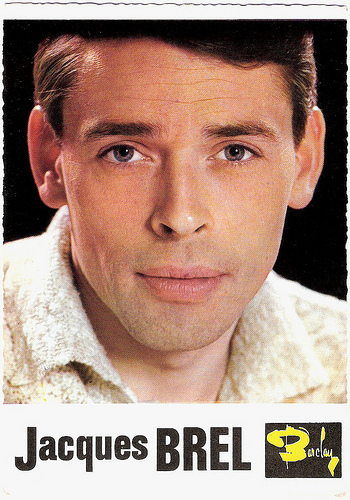
French promotional card by Barclay, no. 248. Photo: Herman Léonard.
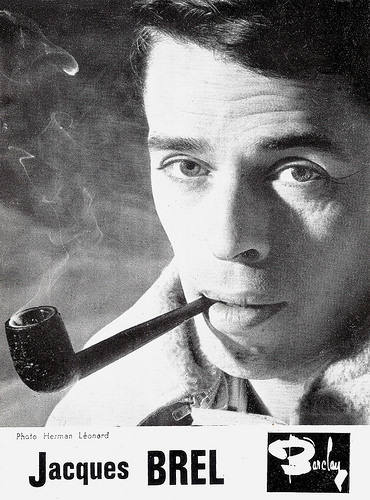
French promotion card by Barclay. Photo: Hermann Léonard.
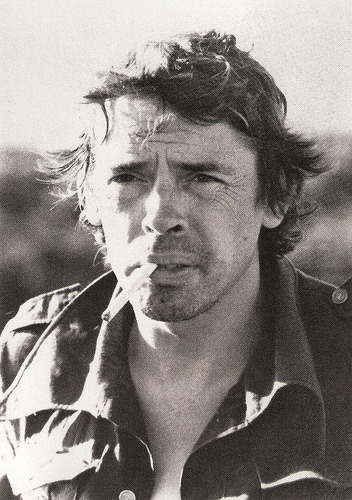
French postcard, no. 214.
Cinema & Theatre
In 1964 Jacques Brel began to consider retiring from music. He was searching out new forms with which to express himself. He got tired of the exstensive touring and he announced in 1966 that he would no longer go on concert tours. He appeared in the film Les risques du metier/Risky Business (André Cayatte, 1967) opposite Emmanuelle Riva .
In 1968 he starred on stage at the Théâtre Royal de la Monnaie in Brussels and the Champs-Elysées Theatre in Paris in the musical L'Homme de la Mancha/Man of La Mancha which he had also translated into French and directed. Then he took the lead role opposite Claude Jade in the film Mon oncle Benjamin/My Uncle Benjamin (Edouard Molinaro, 1969).
Other films in which he appeared were La Bande à Bonnot/Bonnot's Gang (Philippe Fourastié, 1969) with Annie Girardot , Les Assassins de l'Ordre/Law Breakers (Marcel Carné, 1971), L'Aventure, c'est l'Aventure/Money Money Money (Claude Lelouch, 1972) opposite Lino Ventura and Johnny Hallyday , and Le Bar de la Fourche/The Bar at the Crossing (Alain Levent, 1972) with Isabelle Huppert .
His most successful role was again opposite a stone-faced Lino Ventura in the classic black comedy L'Emmerdeur/A Pain in the A... (Edouard Molinaro, 1973). The film was remade with Jack Lemmon and Walter Matthau as Buddy Buddy (Billy Wilder, 1981). Brel also directed, co-wrote and appeared in two films: Franz (Jacques Brel, 1971) with singer Barbara, and the comedy Le Far-West/Far West (Jacques Brel, 1973), which competed for the Palme d'Or at the Cannes Film Festival.
In 1973, Terry Jacks released a revival of Seasons in the Sun that hit number one in both the U.S. and the U.K., followed by a chart entry with his version of If You Go Away. That year Brel had embarked in a yacht, planning to sail around the world. When he reached the Canary Islands, Brel, a heavy smoker, was diagnosed with lung cancer. He returned to Paris for treatment and later continued his ocean voyage.
In 1975 he reached the Marquesas Islands (French Polynesia), and decided to stay, remaining there until 1977 when he returned to Paris and recorded his well-received final album. Jacques Brel died of lung cancer in 1978 in Bobigny in the suburbs of Paris, at age 49. He was buried in Calvary Cemetery in Atuona at the Hiva Oa island in French Polynesia, just a few metres from the painter Paul Gauguin. Quotation: "...in a man's life, there are two important dates: his birth and his death. Everything we do in between is not very important."
Jacques Brel sings Le Moribond. Source: Pa Patrice (YouTube).
Jacques Brel sings Ne Me Quitte Pas. Source: Agora Vox France (YouTube).
Jacques Brel sings Marieke. Source: alenaapril (YouTube).
Jacques Brel sings Dans le Port d Amsterdam. Source: Lukáš Slunečko (YouTube).
French trailer for L'emmerdeur (1973). Source: TV5 Monde (YouTube).
Trailer Jacques Brel is Alive and Well and Living in Paris (1974). Source: Kino International / Kino Classics (YouTube).
Sources: William Ruhlmann (AllMovie), Louis Girard and Hiram Lee (WSWS), Wikipedia, Éditions Jacques Brel, Europopmusic, and .

French postcard by E.D.U.G., no. 262. Photo: Herman Léonard.

Belgian collectors card by Merbotex, Brussels for Cine Memlinc. Photo: Studio Vauclair.

French postcard by Editions P.I., Paris, no. 36.

Dutch postcard by Uitgeverij Syba, Enkhuizen. Promotional postcard for Philips records. Sent by mail in 1963.

French postcard by PSG, no. 263. Offered by Corvisart, Epinal. Photo: Sam Lévin.

French postcard by E.D.U.G., Paris, no. 179. Photo: Sam Lévin.
Catholic-humanist Troubadour
Jacques Romain Georges Brel was born in 1929 in Schaarbeek, a district of Brussels, Belgium. Brel was the son of Romain Brel, who worked in an import-export firm, but later became co-director of a company that manufactured cardboard cartons, and Elisabeth (Lambertine) Brel. Although the Brel family spoke French, they were of Flemish descent, with some of the family originating from Zandvoorde, near Ieper (Ypres).
After quitting school, Jacques started his working life at his father's cardboard factory, apparently destined to follow his father's footsteps. However, he showed an interest in culture, and began playing the guitar at the age of 15. He joined the Catholic-humanist youth organisation Franche Cordée, which organised concerts and shows and Brel began to sing in public, accompanying himself on the guitar. Here he met Thérèse Michielsen ('Miche') who was to become his wife in 1950. A year later, their first daughter, Chantal, was born. Two years later, daughter France was born.
In the early 1950s, Brel achieved minor success in Belgium singing his own songs. In 1953, Jacques Canetti, a talent scout and artistic director with Philips, invited him to come to Paris. A 78 record, La foire/Il y a, was released, which sold 200 copies. Brel carried on writing music and singing in cabarets and music-halls, where he delivered his songs with great energy. He also went on stage at the famous Olympia theatre, as a supporting act.
Juliette Gréco made a recording of his song Ca va, le Diable. Brel did his first French tour, and at the end of 1954 Philips released his debut album, Jacques Brel et Ses Chansons. By 1956 he was touring Europe and he recorded the song Quand on n'a que l'amour (later adapted into English as If We Only Have Love) that brought him his first major recognition and reached number three in the French charts.
He made his film début in the title role of the short La Grande Peur de Monsieur Clément/The Big Fear of Mr. Clément (Paul Diebens, 1956), which he also co-wrote. With his career taking off, his wife and daughters joined him in Paris in February 1958. In August, his third daughter, Isabelle, was born, but by the end of the 1950s Miche and Brel's three daughters had returned to Brussels, while Jacques was always on tour.
From then on he and his family led separate lives. Under the influence of his friend Georges Pasquier ('Jojo') and pianists Gérard Jouannest and Francois Rauber, Brel's style changed. He was no longer a Catholic-humanist troubadour, but sang grimmer songs about love, death, and the struggle that is life. The music became more complex and his themes more diverse, exploring love, society, and spiritual concerns.

French postcard in the series Portraits de Stars - Chanteurs Français by L'Aventure Carto, no. 2. Photo: Marcel Thomas Collection Gérard Gagnepain. This postcard was printed in an edition of 120 cards.

French postcard by Edition du Globe, Paris, no. 782. Photo: Studio Vauclair.

Dutch postcard by Hercules, Haarlem, no. 862.

Dutch postcard by NS, no. 12. With Heidi Brühl.

French postcard by Uitg. Takken, Utrecht, no. AX 4421.

Dutch postcard by Gebr. Spanjersberg (SPARO), Rotterdam, no. 892.

French postcard by Humour à la Carte, Paris, no. 3393. Photo: J.L. Rancurel.
Darkness and Bitter Irony
Jacques Brel was in 1961 contracted by Bruno Coquatrix, director of l'Olympia. Marlène Dietrich had pulled out from a series of shows at the very last moment. Coquatrix wanted Brel to replace her. October 12 to 29, Jacques Brel had star billing at the Olympia for the first time. In 1962 Brel signed with a new record company, the recently formed Barclay Records. Together with his wife, he also founded a publishing company, Editions Musicales Pouchenel.
During the 1960s, Brel was almost constantly on tour. He performed on all the famous stages in the world, including Estrade Theatre in Moscow and Carnegie Hall in New York, where he made his U.S. performing début in 1963. American poet and singer Rod McKuen began writing English lyrics to Brel's songs, and the Kingston Trio recorded Seasons in the Sun, McKuen's version of a song Brel had titled Le Moribond, on their Time to Think LP in 1964.
Brel's romantic lyricism now sometimes revealed darkness and bitter irony. At moments his tender love songs might show flashes of barely suppressed frustration and resentment. His insightful and compassionate portraits of the so-called dregs of society: the alcoholics, drifters, drug addicts, and prostitutes described in L’Ivrogne, Jef, La chanson de Jacky and Amsterdam evaded easy sentimentality, and he was not shy about portraying the unsavoury side of this lifestyle.
On stage, Brel gave additional dimensions to many of his songs, thanks to a strong theatrical sense and an apparently boundless energy. Brel’s appearance at Carnegie Hall in 1965 inspired a musical revue created by composer Mort Schuman and poet Eric Blau. Jacques Brel Is Alive and Well and Living in Paris featured 25 songs by Brel translated into English. The piece ran for five years in New York and played in a number of countries including Great Britain, Canada, South Africa and Sweden.
Brel occasionally included parts in Dutch in his songs as in Marieke, and also recorded Dutch versions of a few songs such as Le Plat Pays (Mijn vlakke land) and Ne me quitte pas (Laat Me Niet Alleen. Brel's attitude towards the Flemish was marked by a love of Flanders and the Flemish countryside, but a marked dislike of the Flemish nationalists ('les Flamingants').

French postcard by Edition P.I., Paris, offered by Les Carbones Korès 'Carboplane', no. 1147A. Photo: Hermann Léonard.

French postcard by Sofraneme, Levallois Perret, no. R 43.

French postcard by Editions F. Nugeron, Star 134. Photo: Air France / Distribution VU. Caption: Jacques Brel, 20 Novembre 1964.

Dutch promotion card by N.V. Dureco, Amsterdam. Photo: Barclay.

French promotional card by Barclay, no. 248. Photo: Herman Léonard.

French promotion card by Barclay. Photo: Hermann Léonard.

French postcard, no. 214.
Cinema & Theatre
In 1964 Jacques Brel began to consider retiring from music. He was searching out new forms with which to express himself. He got tired of the exstensive touring and he announced in 1966 that he would no longer go on concert tours. He appeared in the film Les risques du metier/Risky Business (André Cayatte, 1967) opposite Emmanuelle Riva .
In 1968 he starred on stage at the Théâtre Royal de la Monnaie in Brussels and the Champs-Elysées Theatre in Paris in the musical L'Homme de la Mancha/Man of La Mancha which he had also translated into French and directed. Then he took the lead role opposite Claude Jade in the film Mon oncle Benjamin/My Uncle Benjamin (Edouard Molinaro, 1969).
Other films in which he appeared were La Bande à Bonnot/Bonnot's Gang (Philippe Fourastié, 1969) with Annie Girardot , Les Assassins de l'Ordre/Law Breakers (Marcel Carné, 1971), L'Aventure, c'est l'Aventure/Money Money Money (Claude Lelouch, 1972) opposite Lino Ventura and Johnny Hallyday , and Le Bar de la Fourche/The Bar at the Crossing (Alain Levent, 1972) with Isabelle Huppert .
His most successful role was again opposite a stone-faced Lino Ventura in the classic black comedy L'Emmerdeur/A Pain in the A... (Edouard Molinaro, 1973). The film was remade with Jack Lemmon and Walter Matthau as Buddy Buddy (Billy Wilder, 1981). Brel also directed, co-wrote and appeared in two films: Franz (Jacques Brel, 1971) with singer Barbara, and the comedy Le Far-West/Far West (Jacques Brel, 1973), which competed for the Palme d'Or at the Cannes Film Festival.
In 1973, Terry Jacks released a revival of Seasons in the Sun that hit number one in both the U.S. and the U.K., followed by a chart entry with his version of If You Go Away. That year Brel had embarked in a yacht, planning to sail around the world. When he reached the Canary Islands, Brel, a heavy smoker, was diagnosed with lung cancer. He returned to Paris for treatment and later continued his ocean voyage.
In 1975 he reached the Marquesas Islands (French Polynesia), and decided to stay, remaining there until 1977 when he returned to Paris and recorded his well-received final album. Jacques Brel died of lung cancer in 1978 in Bobigny in the suburbs of Paris, at age 49. He was buried in Calvary Cemetery in Atuona at the Hiva Oa island in French Polynesia, just a few metres from the painter Paul Gauguin. Quotation: "...in a man's life, there are two important dates: his birth and his death. Everything we do in between is not very important."
Jacques Brel sings Le Moribond. Source: Pa Patrice (YouTube).
Jacques Brel sings Ne Me Quitte Pas. Source: Agora Vox France (YouTube).
Jacques Brel sings Marieke. Source: alenaapril (YouTube).
Jacques Brel sings Dans le Port d Amsterdam. Source: Lukáš Slunečko (YouTube).
French trailer for L'emmerdeur (1973). Source: TV5 Monde (YouTube).
Trailer Jacques Brel is Alive and Well and Living in Paris (1974). Source: Kino International / Kino Classics (YouTube).
Sources: William Ruhlmann (AllMovie), Louis Girard and Hiram Lee (WSWS), Wikipedia, Éditions Jacques Brel, Europopmusic, and .
Published on October 23, 2016 22:00
October 22, 2016
Else Frölich
In the 1910s, Else Frölich (1880-1960) or Else Frølich was one of the leading actresses of the Danish Nordisk Company. In many Nordisk films she was paired with the male star of those years, Valdemar Psilander, as in the beautifully restored Evangelimandens liv/The candle and the moth (Holger-Madsen, 1915). She also often played in vehicles which were designed specially for her.
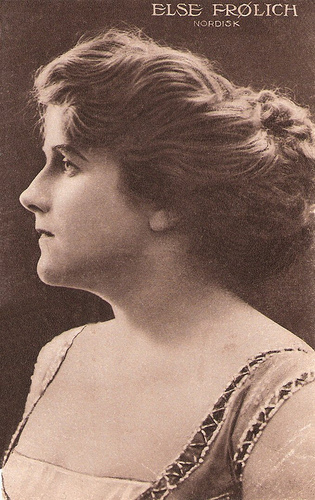
Danish postcard. Photo: Nordisk.
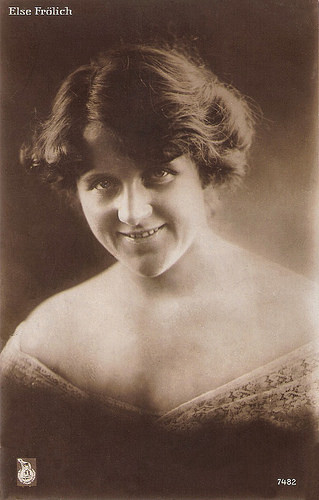
German postcard, no. 7482. Photo: Nordisk.
The Queen of the Season
Else Frölich was born as Eli Marie Thaulow in Paris in 1880. She was the daughter of the Norwegian painter Fritz Thaulow and a Danish mother, Ingeborg Gad, a cousin of the film director Urban Gad. Fritz Thaulow lived in Paris as an international celebrity, and Ingeborg's sister Mette was married to the French painter Paul Gauguin. At the age of 3 years Eli came to Denmark, when her mother married a second time with Edvard Brandes, whom Eli considered her father.
In 1903 Eli married the Danish singer Louis Frölich, whom she divorced in later years (unknown when), but whose name she kept. As 17-year-old she studied singing in Paris and performed with her husband both in Paris and in the Scandinavian countries. She got her first big success with Bear Bjørnsson at the National Theatre in Oslo, where she played the title role in Den glade Enke (The Merry Widow) in 1907. At the Ny Teater (New Theatre) in Copenhagen, she had a huge success with the Dollarprinsessen (Dollar Princess) in 1909.
In 1911 she started to perform in short silent films at the Nordisk film studio and throughout her film career she was exclusively employed there. One of her first appearances was in En lektion/A Lesson (August Blom, 1911) opposite Valdemar Psilander .
In 1912 followed 9 more films. First she played in Guvernorens datter/The Governor's daughter (August Blom, 1912) with Robert Dinesen , and En staerkere magt/A Powerful Force (Hjalmar Davidsen, Eduard Schnedler-Sorensen, 1912).
Then followed five films with Valdemar Psilander and Fröhlich in the leads: Tropisk kaerlighed/Tropical Love (August Blom, 1912), Livets baal/Life's Bonfire (Eduard Schnedler-Sorensen, 1912), Jerbanens dotter/Rail Daughter (August Blom, 1912), Den staerkeste/Vanquished (Eduard Schnedler-Sorensen, Bernhard Holz, 1912), and For Abent Taeppe/Desdemona (August Blom, 1912) in which Psilander and Fröhlich are a couple playing Othello and Desdemona and recognizing their own situation. Next came - still in 1912, Hjaerternes kamp/A High Stake (August Blom, 1912) with Dinesen, and Badets dronning/The Queen of the Season (Eduard Schnedler-Sorensen, 1912).
In 1913 Else played in the comedies Skandalen paa Sorupgaard/The Scandal of Sorupgaard (Hjalmar Davidsen, 1913) with Psilander, Kaerlighed og penge/Outwitted (Leo Tscherning, 1913), and in Djaevelens datter/Devil's daughter (Robert Dinesen, 1913). Director Dinesen also co-starred in this film. The following year she starred a.o. in Detektivens barnepige/Detective Nurse (Hjalmar Davidsen, 1914) and Det gamle fyrtaarn/The Old Lighthouse (A.W. Sandberg, 1914).
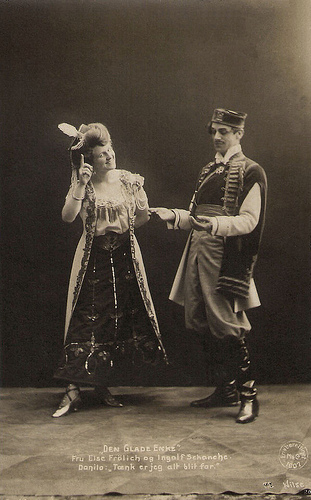
Danish postcard by Ensberelinget M & Co, no. 20, 1907. Photo: Nilse. Publicity still for the Franz Lehar operetta Den Glade Enke/The Merry Widow. The Merry Widow had its premiere in 1905, and the operetta came to Denmark in 1906, where it also was a great success. A year later it was presented in Norway at the Nationalteatret. Else Frölich made her stage début in the title role. Ingolf Schanche played Count Danilo. On the postcard he says: "Thinking I'm all grown father".
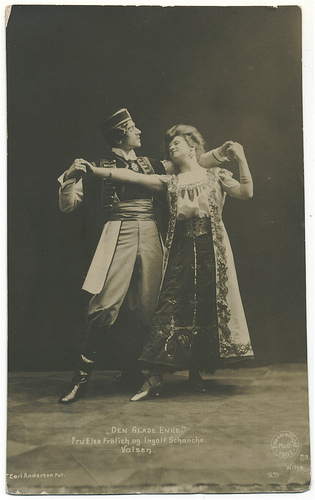
Danish postcard by Valsen_Ensberettiget, no. 29. Photo: Carl Andersen. Collection: Manuel Palomino Arjona (Flickr). Else Frölich & Ingolf Schanche in Den Glade Enke (The Merry Widow).
The Candle and the Moth
Else Fröhlich was the leading female star of Nordisk along with Clara Wieth and Ebba Thomsen, and she continued to play leading roles in numerous films. In 1915 she starred in Evangeliemandens liv/The Candle and the Moth (Holger-Madsen, 1915), a star vehicle for Valdemar Psilander as the spoiled brat who redeems himself in prison, finds faith and becomes a clergyman.
With her a bit chubby but towering beauty she was perfect for the major (erotic) love dramas, where she often played opposite Psilander or Anton de Verdier. She appeared in En opstandelse/A Resurrection (Holger-Madsen, 1915) with Psilander, Millionaeren i roverhaender/Millionaire in Robber's Hands (A.W. Sandberg, 1915), Kampen om barnet/Battle for the Children (Hjalmar Davidsen, 1915), and Cowboymillionaeren/Cowboy Millionaire (Lau Lauritzen Sr., 1915), with Olaf Fönss .
Else Frölich appeared again with Valdemar Psilander in I livets braending/Crossroads of life (Holger-Madsen, 1916) but it was probably their last film together before he died. On 6 March 1917 Psilander committed suicide. It meant the end of the many films of Frölich with the Danish star.
In 1916 Frölich also appeared in Hendes fortid/Her Past (A.W. Sandberg, 1916), Katastrofen i Kattegat/The Disaster in the Kattengat (A.W. Sandberg, 1916), Gentlemansekretaeren/Gentleman Secretary (1916) with Olaf Fönss , and For syn faders skyld/For His Father's Sake (Holger-Madsen, 1916). In 1916 Else Frölich married film director A.W. Sandberg. They stayed together until his death in 1938.
In 1917-1918, Fröhlich only made a handful of films. She appeared in Den raetferdiges hustru/The Righteous Wife (A.W. Sandberg, 1917) with Gunnar Tolnaes , Et bjarneherte/A Child's Heart (Hjalmar Davidsen, 1917). Finally she played in De mystiske fodspor/The mysterious footprints (A.W. Sandberg, 1918) with Carl Brisson , and Solen der draebte/The Sun that Killed (Hjalmar Davidsen, 1918). Her co-star in the latter was the upcoming new film star Nils Asther , who later would pursue a career in Hollywood.
Else Fröhlich retired from the film set in 1918, after a short but intense career. She participated in the preparation of manuscripts, including Klovnen/Clown (based on an idea by Carl Alstrup) and some Charles Dickens adaptations of her husband. Till 1934, she managed the cinema Merry-Biografen together with her son, Henrik Sandberg. Henrik later became a prolific and successful film producer.
Else Frölich died in 1960. The Danish Film Institute has released a DVD with films with Psilander and Frölich such as Evangeliemandens liv/The Candle and the Moth (Holger-Madsen, 1915), while Eye Institute (the former Nederlands Filmmuseum) owns copies of films like Guvernorens datter/The Governor's daughter (August Blom, 1912).
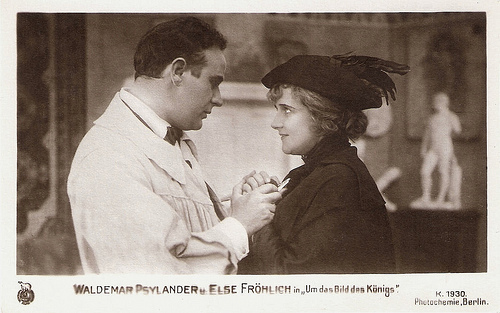
German postcard by Photochemie, Berlin, no. K.1943. Photo: Nordisk Films. Frölich and Valdemar Psilander in Rytterstatuen (A.W. Sandberg 1919). Its German release title was Um das Bild des Königs (For the king's statue).
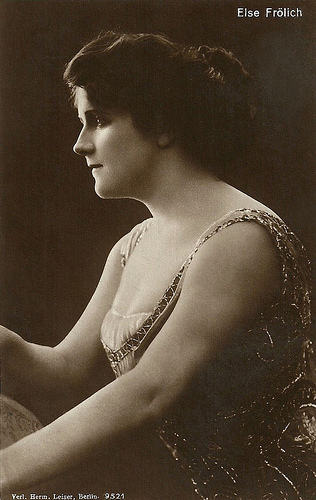
German postcard by Verlag Hermann Leiser, Berlin, no. 9521.
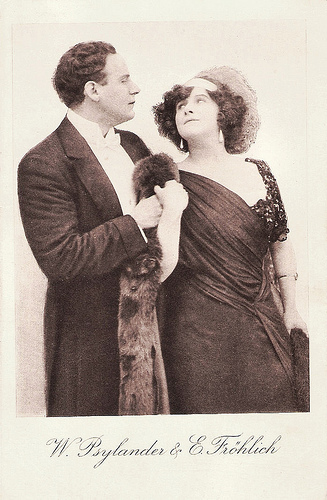
Austrian postcard by Edition Projectograph A.G., no. B.K.W.I. Kino 25. With Valdemar Psilander .
Sources: Det Danske Filminstitut (Danish), Wikipedia (Danish) and .

Danish postcard. Photo: Nordisk.

German postcard, no. 7482. Photo: Nordisk.
The Queen of the Season
Else Frölich was born as Eli Marie Thaulow in Paris in 1880. She was the daughter of the Norwegian painter Fritz Thaulow and a Danish mother, Ingeborg Gad, a cousin of the film director Urban Gad. Fritz Thaulow lived in Paris as an international celebrity, and Ingeborg's sister Mette was married to the French painter Paul Gauguin. At the age of 3 years Eli came to Denmark, when her mother married a second time with Edvard Brandes, whom Eli considered her father.
In 1903 Eli married the Danish singer Louis Frölich, whom she divorced in later years (unknown when), but whose name she kept. As 17-year-old she studied singing in Paris and performed with her husband both in Paris and in the Scandinavian countries. She got her first big success with Bear Bjørnsson at the National Theatre in Oslo, where she played the title role in Den glade Enke (The Merry Widow) in 1907. At the Ny Teater (New Theatre) in Copenhagen, she had a huge success with the Dollarprinsessen (Dollar Princess) in 1909.
In 1911 she started to perform in short silent films at the Nordisk film studio and throughout her film career she was exclusively employed there. One of her first appearances was in En lektion/A Lesson (August Blom, 1911) opposite Valdemar Psilander .
In 1912 followed 9 more films. First she played in Guvernorens datter/The Governor's daughter (August Blom, 1912) with Robert Dinesen , and En staerkere magt/A Powerful Force (Hjalmar Davidsen, Eduard Schnedler-Sorensen, 1912).
Then followed five films with Valdemar Psilander and Fröhlich in the leads: Tropisk kaerlighed/Tropical Love (August Blom, 1912), Livets baal/Life's Bonfire (Eduard Schnedler-Sorensen, 1912), Jerbanens dotter/Rail Daughter (August Blom, 1912), Den staerkeste/Vanquished (Eduard Schnedler-Sorensen, Bernhard Holz, 1912), and For Abent Taeppe/Desdemona (August Blom, 1912) in which Psilander and Fröhlich are a couple playing Othello and Desdemona and recognizing their own situation. Next came - still in 1912, Hjaerternes kamp/A High Stake (August Blom, 1912) with Dinesen, and Badets dronning/The Queen of the Season (Eduard Schnedler-Sorensen, 1912).
In 1913 Else played in the comedies Skandalen paa Sorupgaard/The Scandal of Sorupgaard (Hjalmar Davidsen, 1913) with Psilander, Kaerlighed og penge/Outwitted (Leo Tscherning, 1913), and in Djaevelens datter/Devil's daughter (Robert Dinesen, 1913). Director Dinesen also co-starred in this film. The following year she starred a.o. in Detektivens barnepige/Detective Nurse (Hjalmar Davidsen, 1914) and Det gamle fyrtaarn/The Old Lighthouse (A.W. Sandberg, 1914).

Danish postcard by Ensberelinget M & Co, no. 20, 1907. Photo: Nilse. Publicity still for the Franz Lehar operetta Den Glade Enke/The Merry Widow. The Merry Widow had its premiere in 1905, and the operetta came to Denmark in 1906, where it also was a great success. A year later it was presented in Norway at the Nationalteatret. Else Frölich made her stage début in the title role. Ingolf Schanche played Count Danilo. On the postcard he says: "Thinking I'm all grown father".

Danish postcard by Valsen_Ensberettiget, no. 29. Photo: Carl Andersen. Collection: Manuel Palomino Arjona (Flickr). Else Frölich & Ingolf Schanche in Den Glade Enke (The Merry Widow).
The Candle and the Moth
Else Fröhlich was the leading female star of Nordisk along with Clara Wieth and Ebba Thomsen, and she continued to play leading roles in numerous films. In 1915 she starred in Evangeliemandens liv/The Candle and the Moth (Holger-Madsen, 1915), a star vehicle for Valdemar Psilander as the spoiled brat who redeems himself in prison, finds faith and becomes a clergyman.
With her a bit chubby but towering beauty she was perfect for the major (erotic) love dramas, where she often played opposite Psilander or Anton de Verdier. She appeared in En opstandelse/A Resurrection (Holger-Madsen, 1915) with Psilander, Millionaeren i roverhaender/Millionaire in Robber's Hands (A.W. Sandberg, 1915), Kampen om barnet/Battle for the Children (Hjalmar Davidsen, 1915), and Cowboymillionaeren/Cowboy Millionaire (Lau Lauritzen Sr., 1915), with Olaf Fönss .
Else Frölich appeared again with Valdemar Psilander in I livets braending/Crossroads of life (Holger-Madsen, 1916) but it was probably their last film together before he died. On 6 March 1917 Psilander committed suicide. It meant the end of the many films of Frölich with the Danish star.
In 1916 Frölich also appeared in Hendes fortid/Her Past (A.W. Sandberg, 1916), Katastrofen i Kattegat/The Disaster in the Kattengat (A.W. Sandberg, 1916), Gentlemansekretaeren/Gentleman Secretary (1916) with Olaf Fönss , and For syn faders skyld/For His Father's Sake (Holger-Madsen, 1916). In 1916 Else Frölich married film director A.W. Sandberg. They stayed together until his death in 1938.
In 1917-1918, Fröhlich only made a handful of films. She appeared in Den raetferdiges hustru/The Righteous Wife (A.W. Sandberg, 1917) with Gunnar Tolnaes , Et bjarneherte/A Child's Heart (Hjalmar Davidsen, 1917). Finally she played in De mystiske fodspor/The mysterious footprints (A.W. Sandberg, 1918) with Carl Brisson , and Solen der draebte/The Sun that Killed (Hjalmar Davidsen, 1918). Her co-star in the latter was the upcoming new film star Nils Asther , who later would pursue a career in Hollywood.
Else Fröhlich retired from the film set in 1918, after a short but intense career. She participated in the preparation of manuscripts, including Klovnen/Clown (based on an idea by Carl Alstrup) and some Charles Dickens adaptations of her husband. Till 1934, she managed the cinema Merry-Biografen together with her son, Henrik Sandberg. Henrik later became a prolific and successful film producer.
Else Frölich died in 1960. The Danish Film Institute has released a DVD with films with Psilander and Frölich such as Evangeliemandens liv/The Candle and the Moth (Holger-Madsen, 1915), while Eye Institute (the former Nederlands Filmmuseum) owns copies of films like Guvernorens datter/The Governor's daughter (August Blom, 1912).

German postcard by Photochemie, Berlin, no. K.1943. Photo: Nordisk Films. Frölich and Valdemar Psilander in Rytterstatuen (A.W. Sandberg 1919). Its German release title was Um das Bild des Königs (For the king's statue).

German postcard by Verlag Hermann Leiser, Berlin, no. 9521.

Austrian postcard by Edition Projectograph A.G., no. B.K.W.I. Kino 25. With Valdemar Psilander .
Sources: Det Danske Filminstitut (Danish), Wikipedia (Danish) and .
Published on October 22, 2016 22:00
October 21, 2016
Imported from the USA: Broderick Crawford
The series Imported from the USA is back! Hard-living and hard-drinking American actor Broderick Crawford (1911–1986) was often cast in tough-guy roles. He is best known for his portrayal of politician Willie Stark in All the King's Men (1949) and for his starring role as Chief Dan Matthews in the television series Highway Patrol (1955-1959). In Europe he appeared in some Peplums but also in Federico Fellini’s Il Bidone (1955).
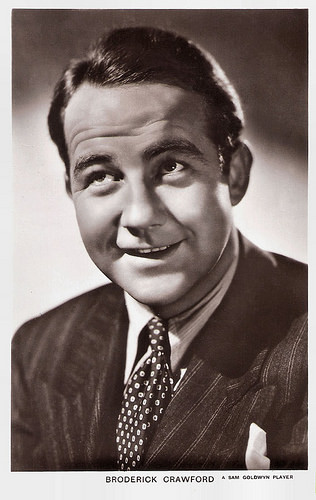
British postcard in the Picturegoer Series, London, no. 1399. Photo: Sam Goldwyn.
Stereotyped as a fast-talking tough guy
William Broderick Crawford was born in Philadelphia, Pennsylvania, in 1911. His parents were Lester Crawford and Helen Broderick, who were both vaudeville performers, as his grandparents had been. Lester Crawford appeared in films in the 1920s and 1930s, and his mother had a minor career in Hollywood comedies, including a memorable appearance as Madge in the classic musical Top Hat.
Young William joined his parents on stage, working for producer Max Gordon. After graduating from high school, Crawford was accepted by Harvard College where he enrolled. However, after only three weeks at Harvard he dropped out to work as a dockworker on the New York docks.
Crawford returned to vaudeville and radio, which included a period with the Marx Brothers on the radio comedy show Flywheel, Shyster, and Flywheel (1932-1933). He played his first serious character as a footballer in She Loves Me Not at the Adelphi Theatre, London in 1932.
Early in his career, Crawford was stereotyped as a fast-talking tough guy and often played villainous parts. He realized he did not fit the role of a handsome leading man, once describing himself as looking like a 'retired pugilist'. In 1937, he gained fame as Lennie in John Steinbeck’s Of Mice and Men on Broadway.
Crawford moved to Hollywood, and made his film debut in the comedy Eva en Co (John G. Blystone, 1937), in a supporting role to stars Joel McCrea and Miriam Hopkins. Crawford did not play Lennie in the film version of Of Mice and Men (Lewis Milestone, 1939). Lon Chaney Jr. starred in the film version as Lenny.
However, Crawford was selected for a supporting role in the successful action/adventure film Beau Geste (William A. Wellman, 1939). He followed this up with another important supporting role as a big but kind-hearted lug in the gangster spoof Larceny, Inc. (Lloyd Bacon, 1942) with Edward G. Robinson.
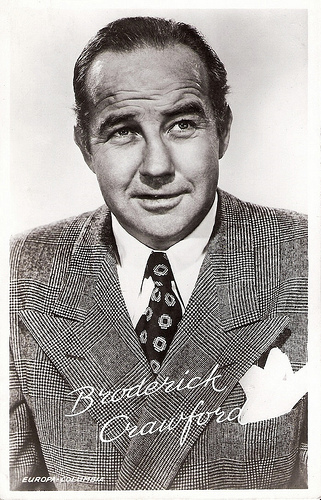
Dutch postcard by Takken / 'T Sticht, Utrecht, no. 3327. Photo: Europa-Columbia.
The pinnacle of his acting career
During World War II, Broderick Crawford enlisted in the United States Army Air Corps. Assigned to the Armed Forces Network, he was sent to Britain in 1944 as a sergeant, he served as an announcer for the Glenn Miller American Band.
After the war, his career was first largely limited to B films in supporting or character roles. Nevertheless, he excelled in roles playing villains. In 1949, he reached the pinnacle of his acting career when he was cast in the Film Noir All the King's Men (Robert Rossen, 1949), based on the Pulitzer Prize-winning novel by Robert Penn Warren.
He played the ambitious and sometimes ruthless politician Willie Stark, a character inspired by Louisiana politician Huey Long. The film was a huge hit, and Crawford's performance as the bullying, blustering, yet insecure Governor Stark won him the Academy Award for Best Actor.
The following year, the actor would star in another hit 'A'-list production, the comedy-drama Born Yesterday (George Cukor, 1950) with William Holden. He was memorable as Judy Holliday's boisterous boyfriend.
His Academy Award and larger-than-life persona won him more diverse roles, and he appeared in such varied films as Scandal Sheet (Phil Karlson, 1952), Fritz Lang's Human Desire (1954) and Between Heaven and Hell (Richard Fleischer, 1956).
In 1955, Crawford assumed the starring role as Rollo Lamar, the most violent of convicts in Big House, U.S.A. (Howard W. Koch, 1955). In the film, Crawford's character is a hardened convict so violent he commands the obedience of even the most violent and psychotic prisoners in the prison yard, including those portrayed by such famous tough-guy actors as Charles Bronson, Ralph Meeker, and Lon Chaney, Jr.
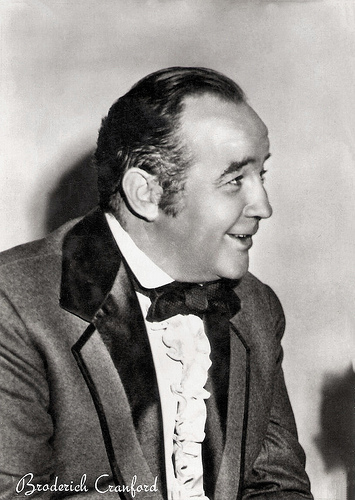
Italian postcard by Rotalfoto, Milano, no. 8.
A hard-as-nails police official
Broderick Crawford also worked in Europe. He starred opposite Richard Basehart and Giulietta Masina in Federico Fellini's comedy Il bidone/The Swindle (1955). The film follows the exploits of a group of swindlers, focusing on their aging leader Augusto (Crawford), as they go about their ‘business,’ reaping both rewards and consequences.
He appeared also in Stanley Kramer's melodrama Not as a Stranger (1955) with Olivia de Havilland, Robert Mitchum and Frank Sinatra. He was rather improbable as a fast-draw outlaw opposite Glenn Ford in the Western The Fastest Gun Alive (Russerll Rouse, 1956).
In 1955, television producer Frederick Ziv of ZIV Television Productions offered Crawford the lead role as Dan Mathews in the police drama Highway Patrol (1955–1959), which dramatized law enforcement activities of the California Highway Patrol. ZIV operated on an extremely low budget of $25,000 per episode but Crawford would receive ten percent of the gross receipts per his contract.
While the show's scripts were largely fictional, the use of realistic dialogue and Crawford's convincing portrayal of a hard-as-nails police official helped make the show an instant success. Highway Patrol helped revive Crawford's career and cement his 'tough guy' persona, which he used successfully in numerous film and TV roles for the rest of his life.
Fed up with the show's hectic shooting schedule, Crawford quit Highway Patrol at the end of 1959 in order to make a film in Europe, and try to get his drinking under control. He appeared as the villain in the Italian-French Peplum (Sword and sandal film) La vendetta di Ercole/Goliath and the Dragon (Vitoria Cottafavi, 1960) with bodybuilder Mark Forest as Hercules/Goliath. Later Crawford also appeared in the Spanish Peplum El Valle de las espadas/The Castilian (Javier Setó, 1963) with Frankie Avalon.
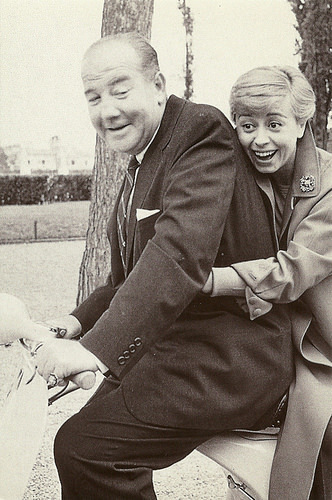
Italian postcard by Ed Graphicarta, Pontedera for Piaggio in the series Kit Postcards Vespa. Giuliette Masina and Crawford played together in Il bidone (Federico Fellini, 1955).
Bouts of heavy alcohol consumption and large meals
Broderick Crawford's successful run as Dan Mathews in Highway Patrol (1955–1959) earned him some two million dollars under his contract with ZIV. Back from Europe, and having temporarily stopped drinking, Crawford signed to star in King of Diamonds (1961-1962) as diamond industry security chief John King.
In 1962, after the end of the series, Crawford returned to acting in European-made films. Between 1962–1970, Crawford appeared in no less than seventeen additional films, though many of them failed to generate much box office success.
After 1970, Crawford again returned to television. He played the role of Dr. Peter Goldstone in The Interns (Marvin J. Chomsky a.o., 1970-1971). In 1977, he starred as FBI director J. Edgar Hoover in the TV movie The Private Files of J. Edgar Hoover (Larry Cohen, 1977). He would eventually make a series of guest appearances in several made-for-TV movies.
Crawford worked in 140 motion pictures and television series during his career and remained an especially durable presence in television. One of his last roles was as a film producer who is murdered in a 1982 episode of the TV detective series Simon & Simon (Burt Kennedy a.o., 1981-1989). The actor who played the part of the suspected murderer was Stuart Whitman, who had played the recurring part of Sergeant Walters on Highway Patrol.
His final feature film was the Austrian-American production Den Tüchtigen gehört die Welt/The Uppercrust (Peter Patzak, 1982). Throughout his adult life, Crawford was prone to bouts of heavy alcohol consumption, and was known for eating large meals. These habits contributed to a serious weight gain for Crawford during the 1950s. During the filming of Highway Patrol, Crawford's heavy drinking increased. It resulted in several arrests and stops for driving under the influence of alcohol (DUI), which eventually gained him a suspended driving license.
Broderick Crawford died following a series of strokes in 1986 at the age of 74 in Rancho Mirage, California. He had been married three times, to actress Kay Griffith (1940–1958; divorced); to Joan Tabor (1962–1967; divorced) and to Mary Alice Moore (1973–1986; his death). He had two sons, Christopher Broderick Crawford (1947-2002) and Kelly Griffith Crawford (1951–2012) from his marriage to Kay Griffith.
Trailer All the King's Men (1949). Source: eddies Movies77 (YouTube).
Italian trailer for Il bidone/The Swindle (1955). Source: chatnel numéro 5 (YouTube).
Trailer for La vendetta di Ercole/Goliath and the Dragon (1960). Source: BestDomainVidz (YouTube).
Sources: (IMDb), Wikipedia, and .

British postcard in the Picturegoer Series, London, no. 1399. Photo: Sam Goldwyn.
Stereotyped as a fast-talking tough guy
William Broderick Crawford was born in Philadelphia, Pennsylvania, in 1911. His parents were Lester Crawford and Helen Broderick, who were both vaudeville performers, as his grandparents had been. Lester Crawford appeared in films in the 1920s and 1930s, and his mother had a minor career in Hollywood comedies, including a memorable appearance as Madge in the classic musical Top Hat.
Young William joined his parents on stage, working for producer Max Gordon. After graduating from high school, Crawford was accepted by Harvard College where he enrolled. However, after only three weeks at Harvard he dropped out to work as a dockworker on the New York docks.
Crawford returned to vaudeville and radio, which included a period with the Marx Brothers on the radio comedy show Flywheel, Shyster, and Flywheel (1932-1933). He played his first serious character as a footballer in She Loves Me Not at the Adelphi Theatre, London in 1932.
Early in his career, Crawford was stereotyped as a fast-talking tough guy and often played villainous parts. He realized he did not fit the role of a handsome leading man, once describing himself as looking like a 'retired pugilist'. In 1937, he gained fame as Lennie in John Steinbeck’s Of Mice and Men on Broadway.
Crawford moved to Hollywood, and made his film debut in the comedy Eva en Co (John G. Blystone, 1937), in a supporting role to stars Joel McCrea and Miriam Hopkins. Crawford did not play Lennie in the film version of Of Mice and Men (Lewis Milestone, 1939). Lon Chaney Jr. starred in the film version as Lenny.
However, Crawford was selected for a supporting role in the successful action/adventure film Beau Geste (William A. Wellman, 1939). He followed this up with another important supporting role as a big but kind-hearted lug in the gangster spoof Larceny, Inc. (Lloyd Bacon, 1942) with Edward G. Robinson.

Dutch postcard by Takken / 'T Sticht, Utrecht, no. 3327. Photo: Europa-Columbia.
The pinnacle of his acting career
During World War II, Broderick Crawford enlisted in the United States Army Air Corps. Assigned to the Armed Forces Network, he was sent to Britain in 1944 as a sergeant, he served as an announcer for the Glenn Miller American Band.
After the war, his career was first largely limited to B films in supporting or character roles. Nevertheless, he excelled in roles playing villains. In 1949, he reached the pinnacle of his acting career when he was cast in the Film Noir All the King's Men (Robert Rossen, 1949), based on the Pulitzer Prize-winning novel by Robert Penn Warren.
He played the ambitious and sometimes ruthless politician Willie Stark, a character inspired by Louisiana politician Huey Long. The film was a huge hit, and Crawford's performance as the bullying, blustering, yet insecure Governor Stark won him the Academy Award for Best Actor.
The following year, the actor would star in another hit 'A'-list production, the comedy-drama Born Yesterday (George Cukor, 1950) with William Holden. He was memorable as Judy Holliday's boisterous boyfriend.
His Academy Award and larger-than-life persona won him more diverse roles, and he appeared in such varied films as Scandal Sheet (Phil Karlson, 1952), Fritz Lang's Human Desire (1954) and Between Heaven and Hell (Richard Fleischer, 1956).
In 1955, Crawford assumed the starring role as Rollo Lamar, the most violent of convicts in Big House, U.S.A. (Howard W. Koch, 1955). In the film, Crawford's character is a hardened convict so violent he commands the obedience of even the most violent and psychotic prisoners in the prison yard, including those portrayed by such famous tough-guy actors as Charles Bronson, Ralph Meeker, and Lon Chaney, Jr.

Italian postcard by Rotalfoto, Milano, no. 8.
A hard-as-nails police official
Broderick Crawford also worked in Europe. He starred opposite Richard Basehart and Giulietta Masina in Federico Fellini's comedy Il bidone/The Swindle (1955). The film follows the exploits of a group of swindlers, focusing on their aging leader Augusto (Crawford), as they go about their ‘business,’ reaping both rewards and consequences.
He appeared also in Stanley Kramer's melodrama Not as a Stranger (1955) with Olivia de Havilland, Robert Mitchum and Frank Sinatra. He was rather improbable as a fast-draw outlaw opposite Glenn Ford in the Western The Fastest Gun Alive (Russerll Rouse, 1956).
In 1955, television producer Frederick Ziv of ZIV Television Productions offered Crawford the lead role as Dan Mathews in the police drama Highway Patrol (1955–1959), which dramatized law enforcement activities of the California Highway Patrol. ZIV operated on an extremely low budget of $25,000 per episode but Crawford would receive ten percent of the gross receipts per his contract.
While the show's scripts were largely fictional, the use of realistic dialogue and Crawford's convincing portrayal of a hard-as-nails police official helped make the show an instant success. Highway Patrol helped revive Crawford's career and cement his 'tough guy' persona, which he used successfully in numerous film and TV roles for the rest of his life.
Fed up with the show's hectic shooting schedule, Crawford quit Highway Patrol at the end of 1959 in order to make a film in Europe, and try to get his drinking under control. He appeared as the villain in the Italian-French Peplum (Sword and sandal film) La vendetta di Ercole/Goliath and the Dragon (Vitoria Cottafavi, 1960) with bodybuilder Mark Forest as Hercules/Goliath. Later Crawford also appeared in the Spanish Peplum El Valle de las espadas/The Castilian (Javier Setó, 1963) with Frankie Avalon.

Italian postcard by Ed Graphicarta, Pontedera for Piaggio in the series Kit Postcards Vespa. Giuliette Masina and Crawford played together in Il bidone (Federico Fellini, 1955).
Bouts of heavy alcohol consumption and large meals
Broderick Crawford's successful run as Dan Mathews in Highway Patrol (1955–1959) earned him some two million dollars under his contract with ZIV. Back from Europe, and having temporarily stopped drinking, Crawford signed to star in King of Diamonds (1961-1962) as diamond industry security chief John King.
In 1962, after the end of the series, Crawford returned to acting in European-made films. Between 1962–1970, Crawford appeared in no less than seventeen additional films, though many of them failed to generate much box office success.
After 1970, Crawford again returned to television. He played the role of Dr. Peter Goldstone in The Interns (Marvin J. Chomsky a.o., 1970-1971). In 1977, he starred as FBI director J. Edgar Hoover in the TV movie The Private Files of J. Edgar Hoover (Larry Cohen, 1977). He would eventually make a series of guest appearances in several made-for-TV movies.
Crawford worked in 140 motion pictures and television series during his career and remained an especially durable presence in television. One of his last roles was as a film producer who is murdered in a 1982 episode of the TV detective series Simon & Simon (Burt Kennedy a.o., 1981-1989). The actor who played the part of the suspected murderer was Stuart Whitman, who had played the recurring part of Sergeant Walters on Highway Patrol.
His final feature film was the Austrian-American production Den Tüchtigen gehört die Welt/The Uppercrust (Peter Patzak, 1982). Throughout his adult life, Crawford was prone to bouts of heavy alcohol consumption, and was known for eating large meals. These habits contributed to a serious weight gain for Crawford during the 1950s. During the filming of Highway Patrol, Crawford's heavy drinking increased. It resulted in several arrests and stops for driving under the influence of alcohol (DUI), which eventually gained him a suspended driving license.
Broderick Crawford died following a series of strokes in 1986 at the age of 74 in Rancho Mirage, California. He had been married three times, to actress Kay Griffith (1940–1958; divorced); to Joan Tabor (1962–1967; divorced) and to Mary Alice Moore (1973–1986; his death). He had two sons, Christopher Broderick Crawford (1947-2002) and Kelly Griffith Crawford (1951–2012) from his marriage to Kay Griffith.
Trailer All the King's Men (1949). Source: eddies Movies77 (YouTube).
Italian trailer for Il bidone/The Swindle (1955). Source: chatnel numéro 5 (YouTube).
Trailer for La vendetta di Ercole/Goliath and the Dragon (1960). Source: BestDomainVidz (YouTube).
Sources: (IMDb), Wikipedia, and .
Published on October 21, 2016 22:00
Paul van Yperen's Blog
- Paul van Yperen's profile
- 13 followers
Paul van Yperen isn't a Goodreads Author
(yet),
but they
do have a blog,
so here are some recent posts imported from
their feed.



